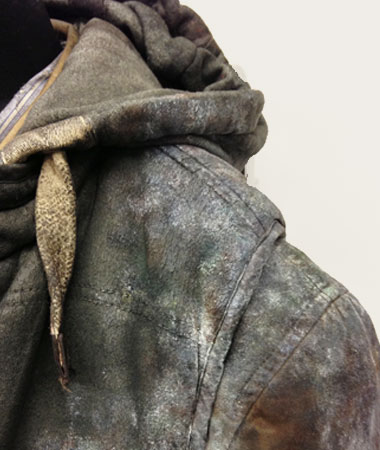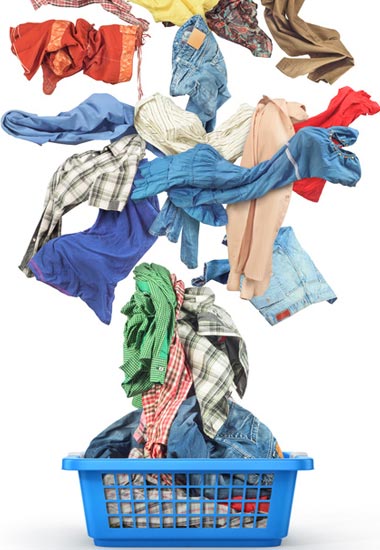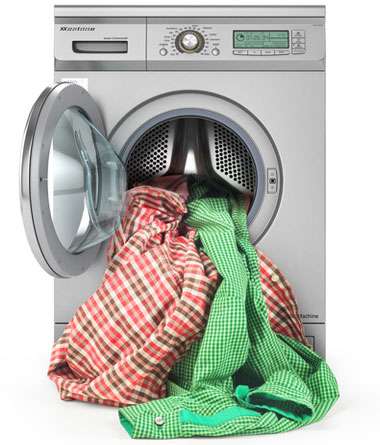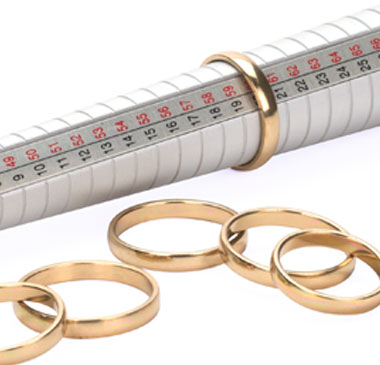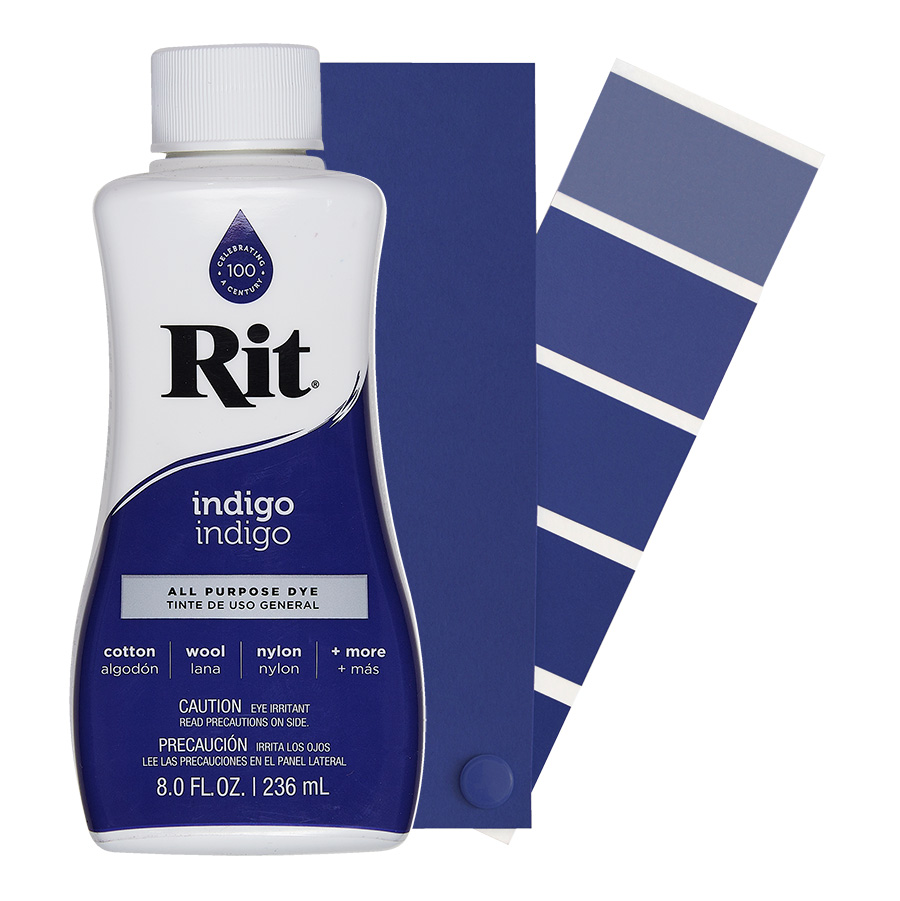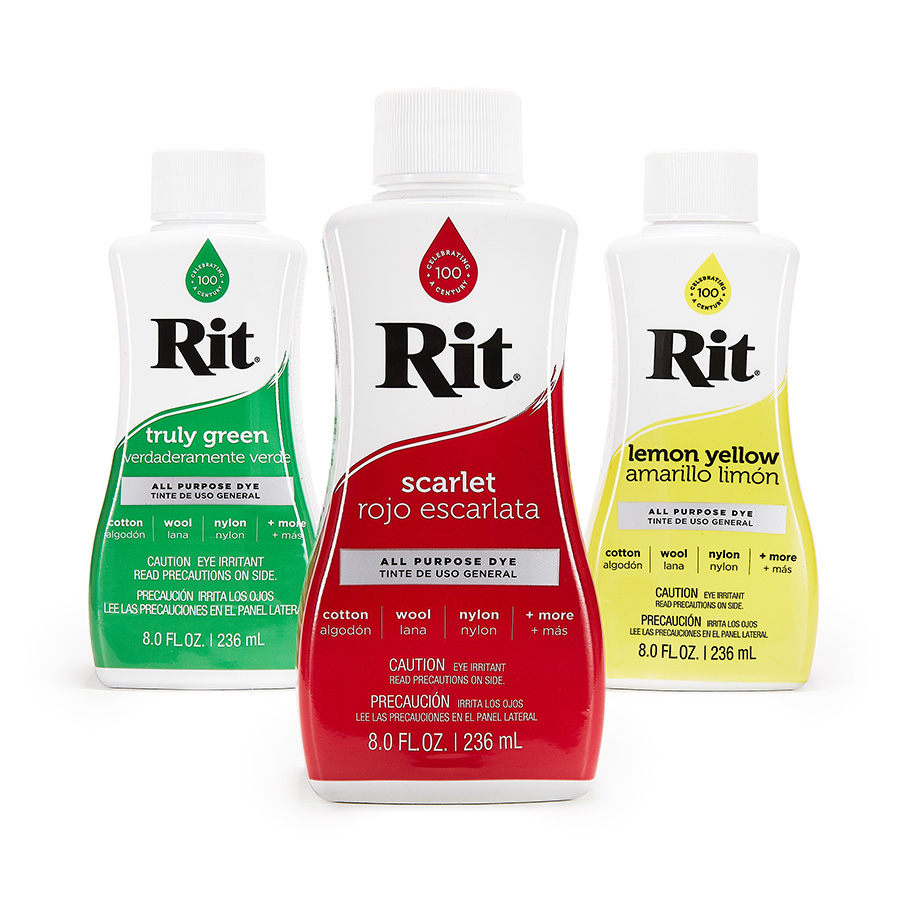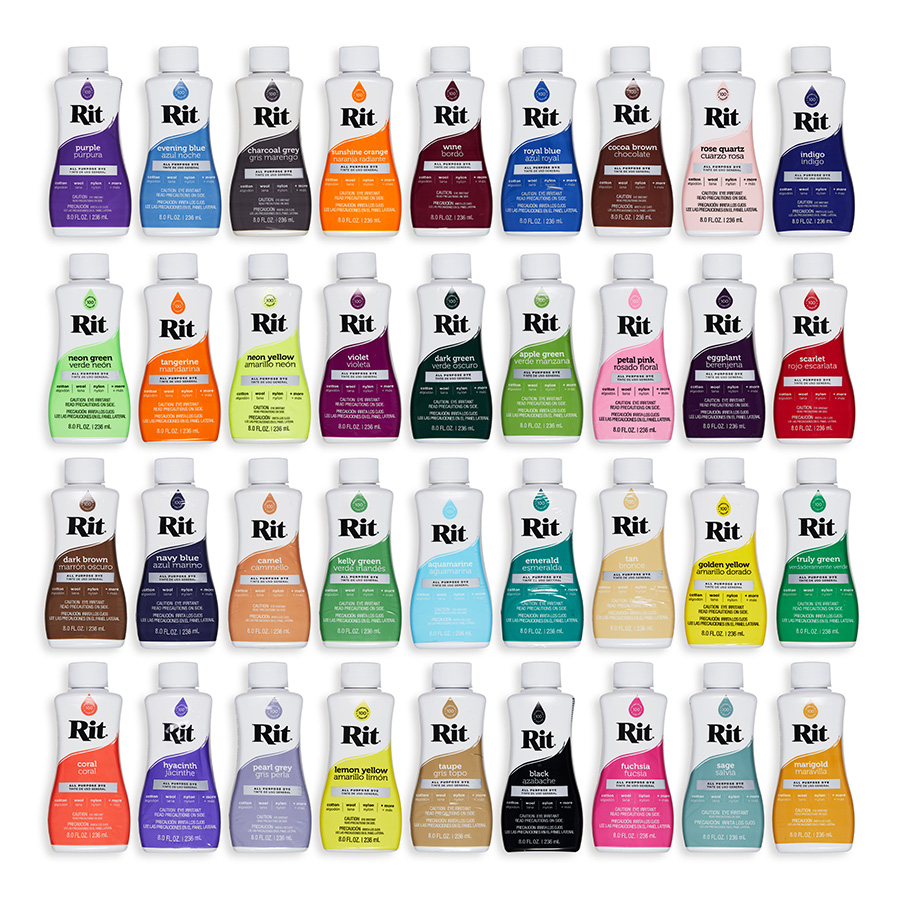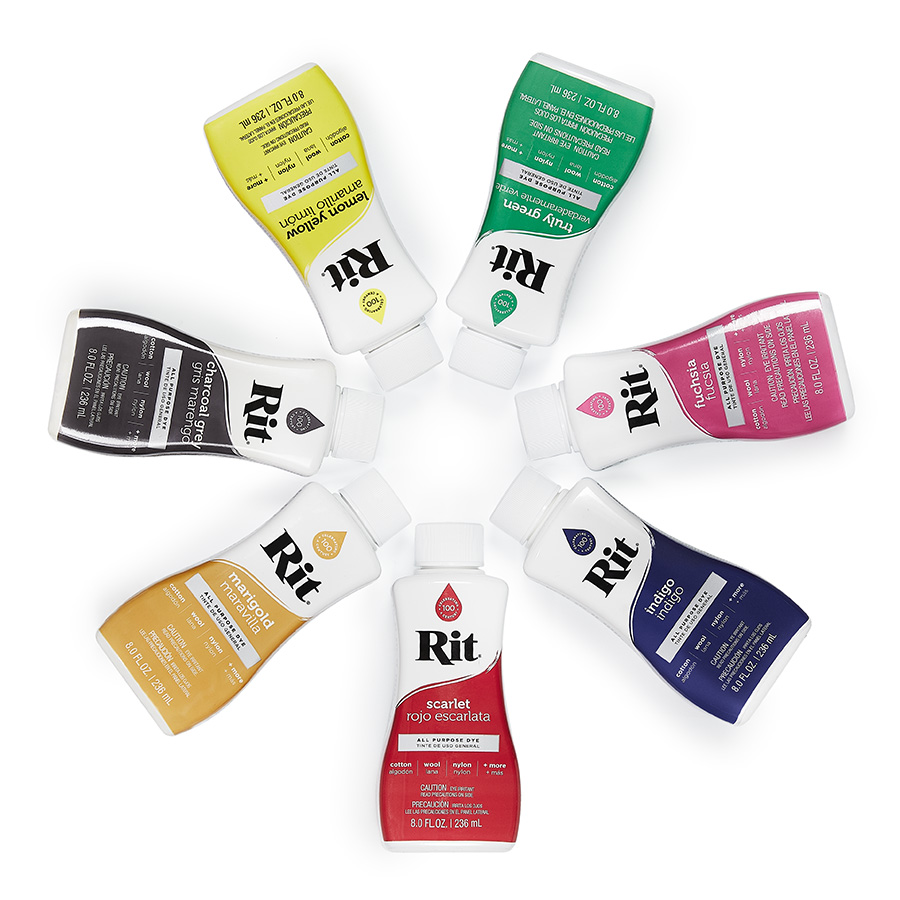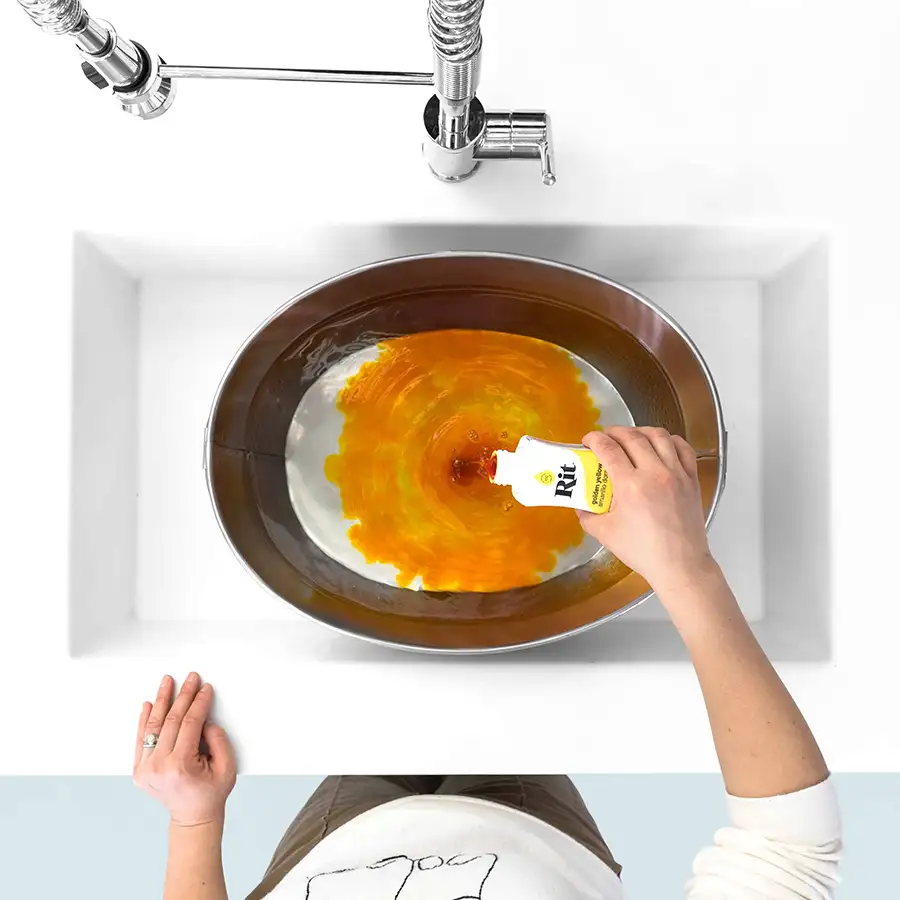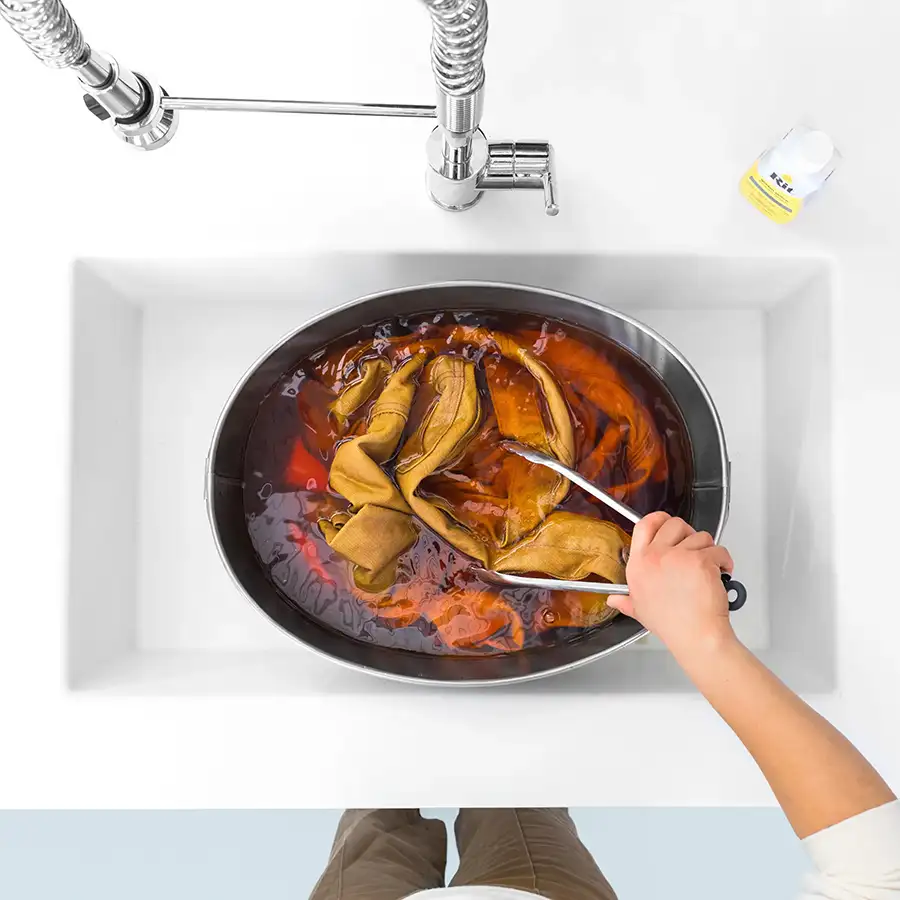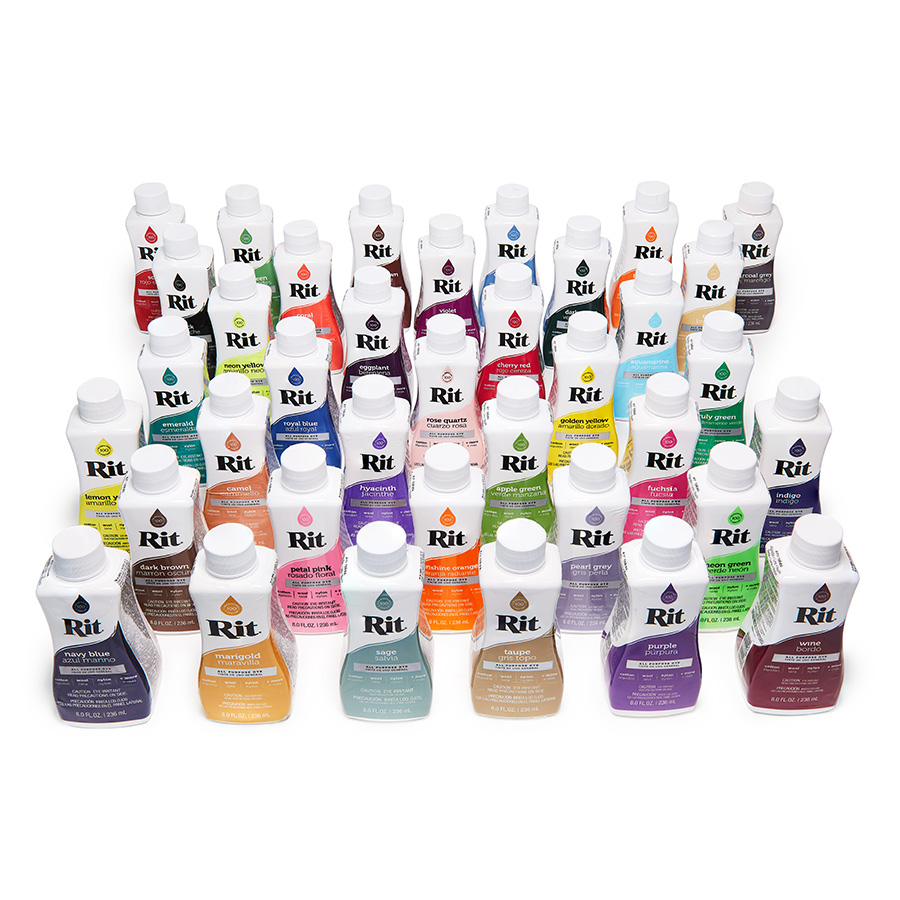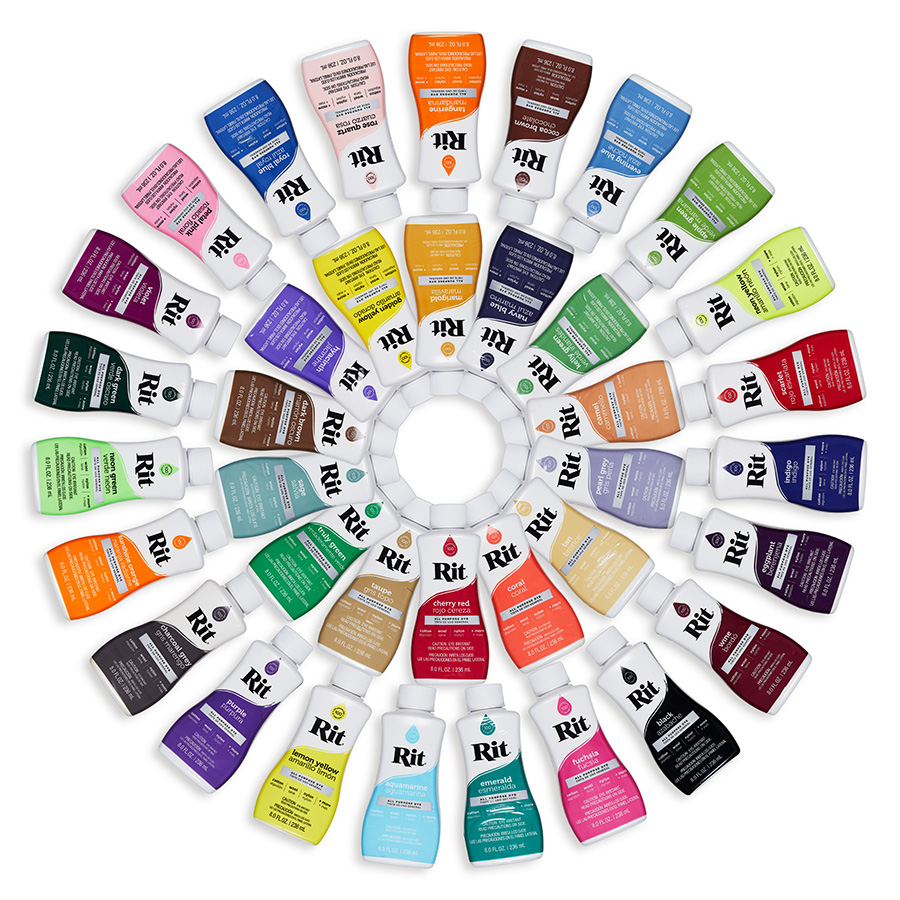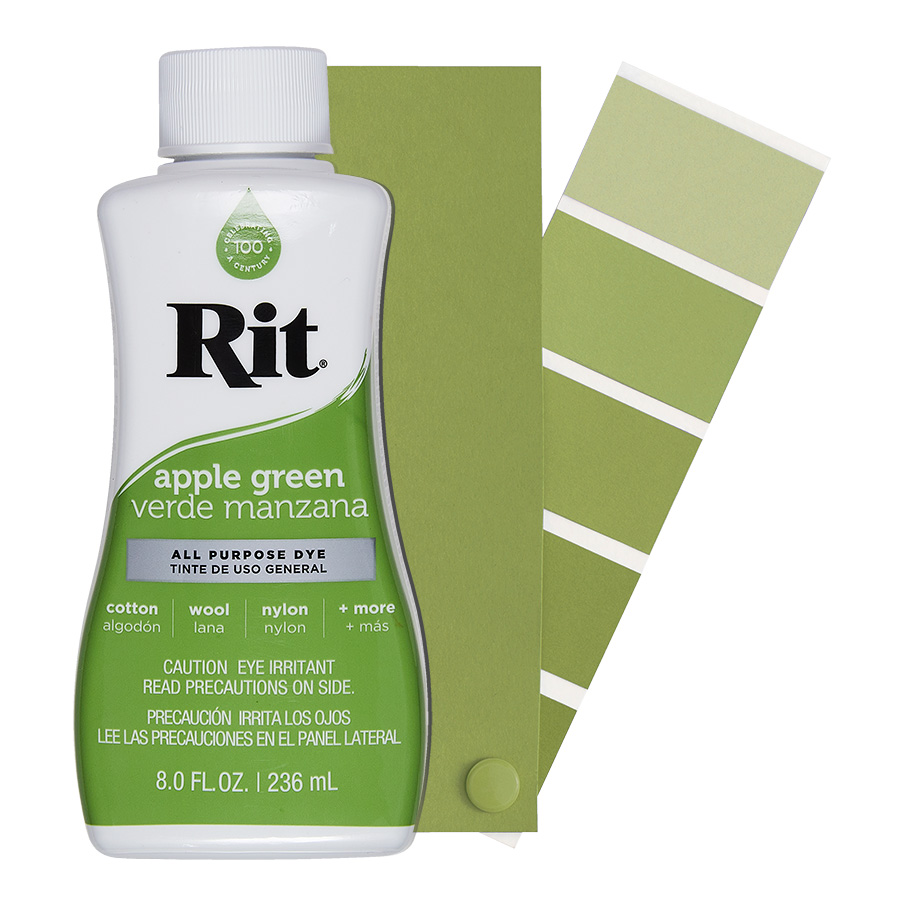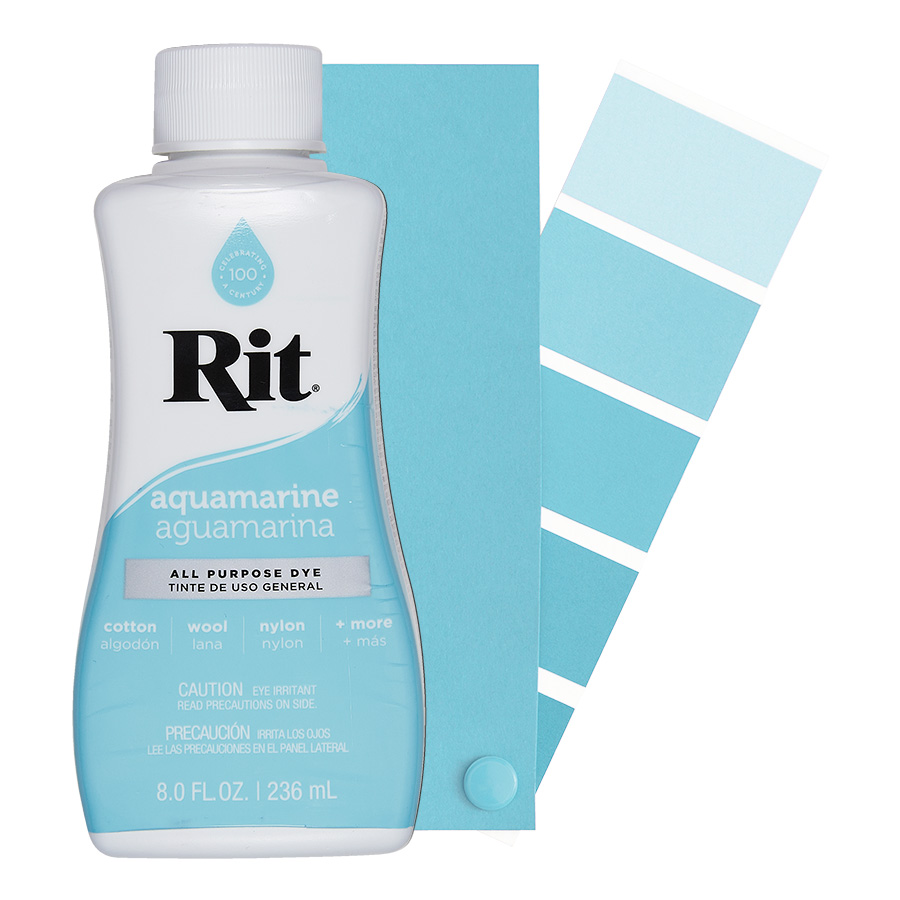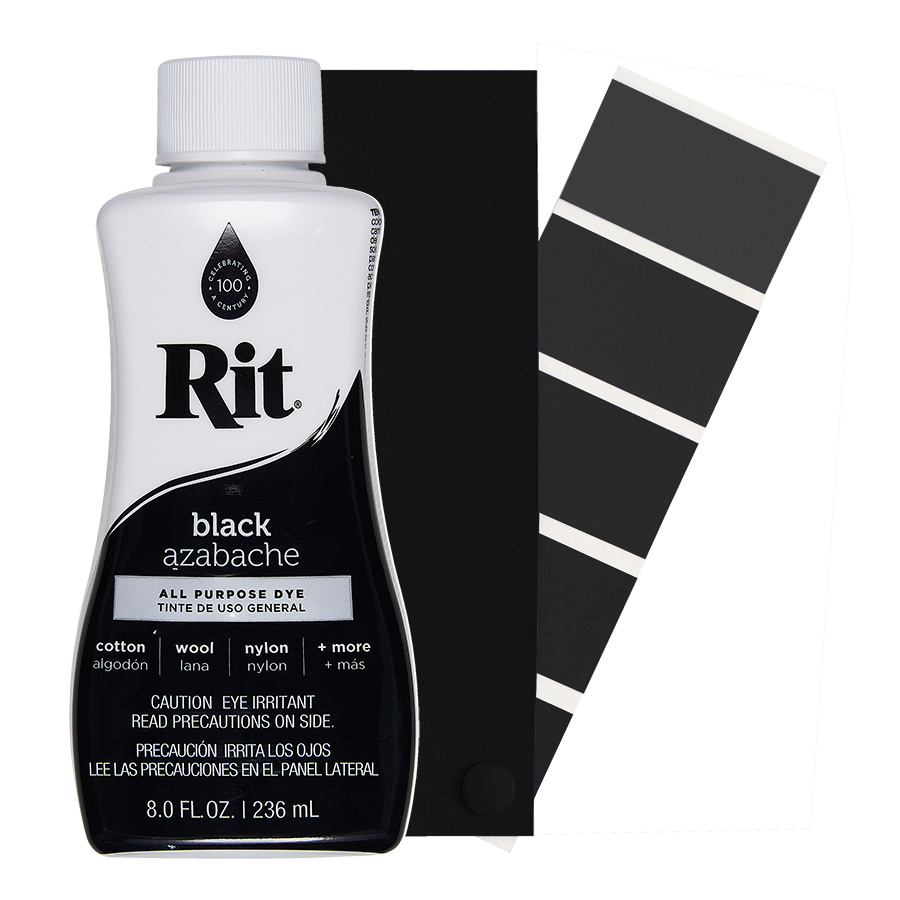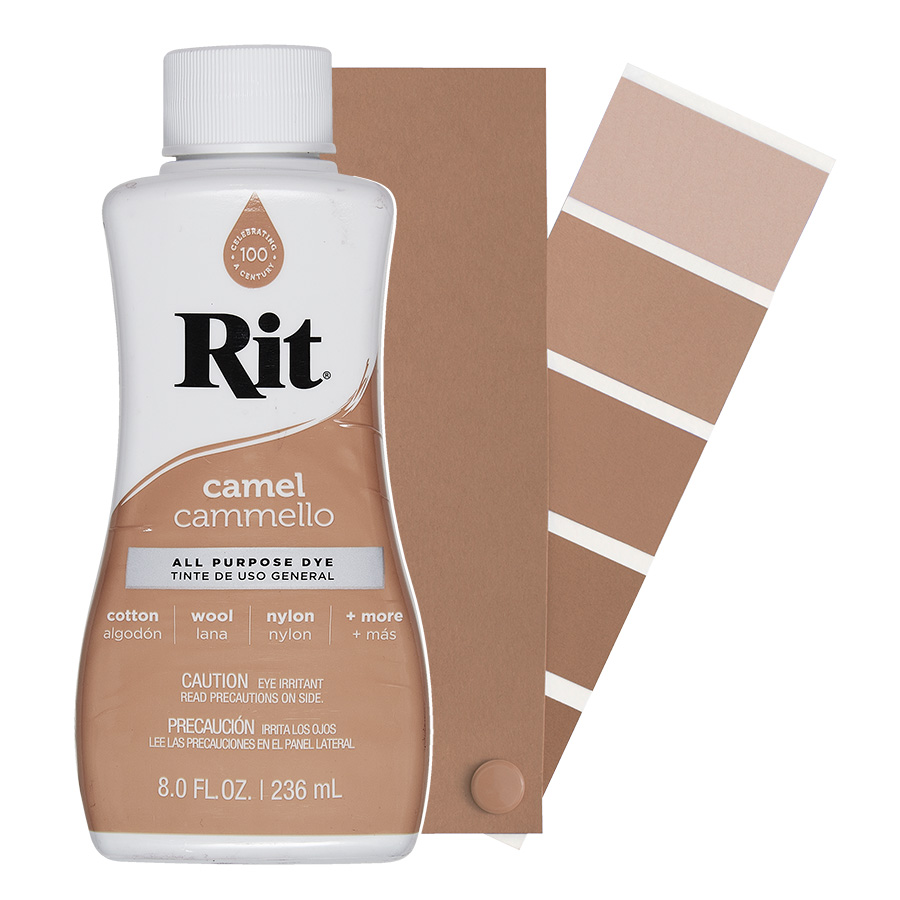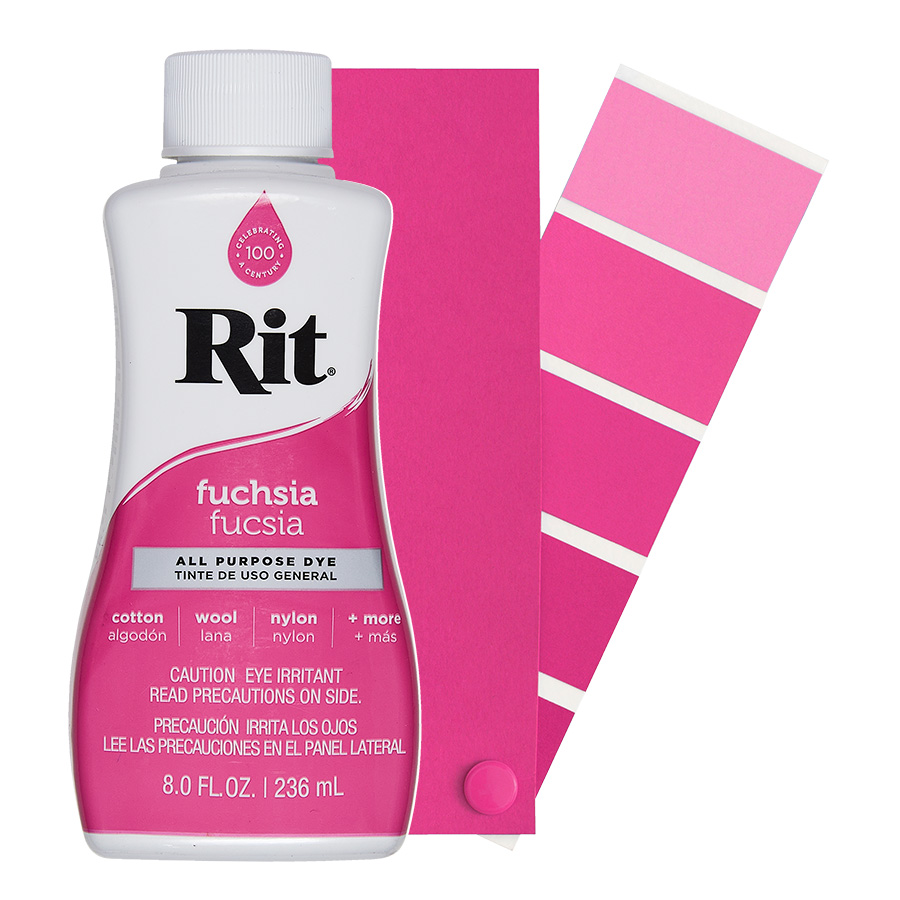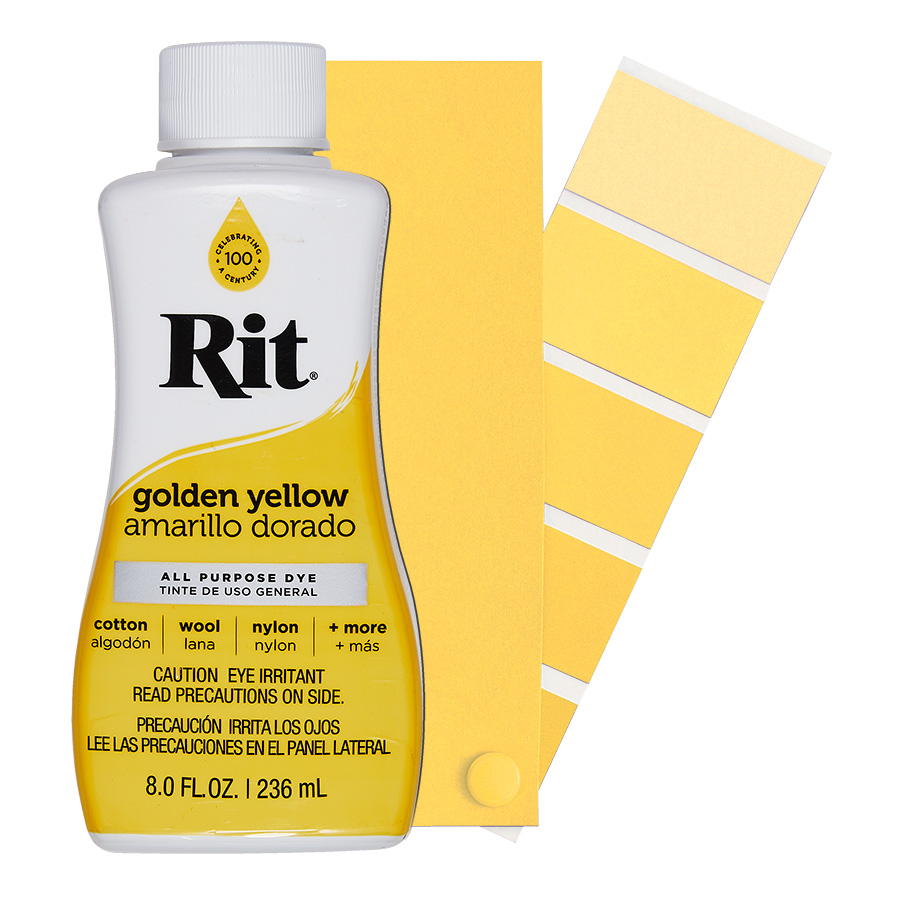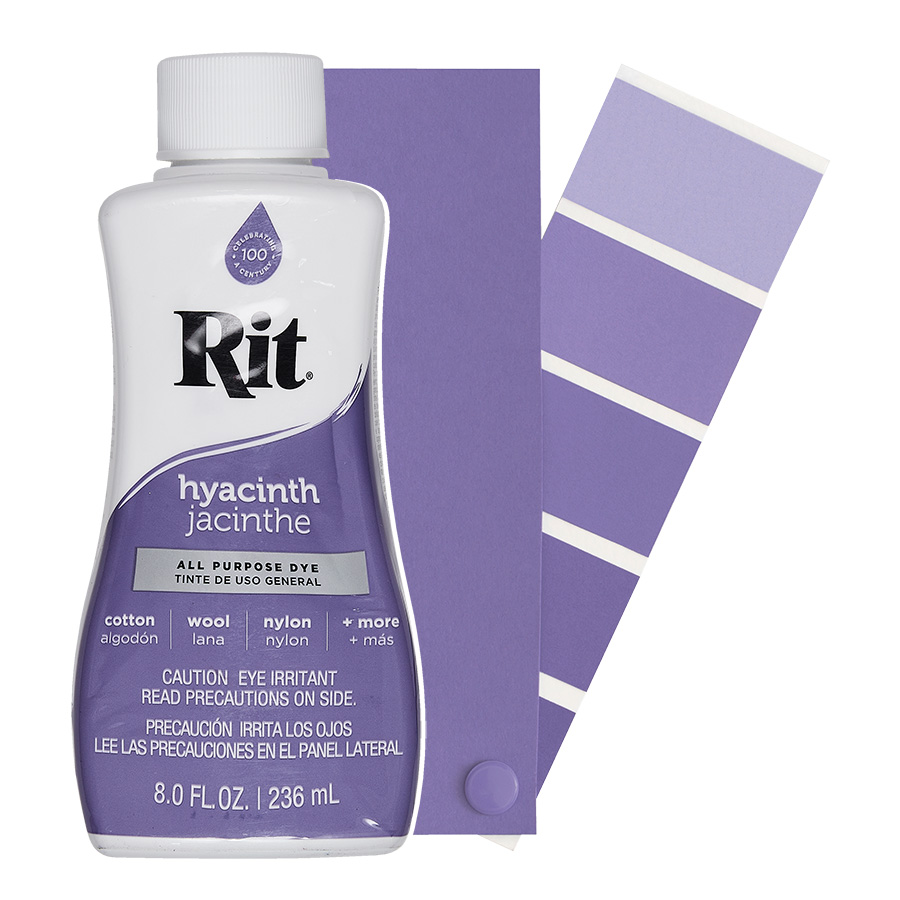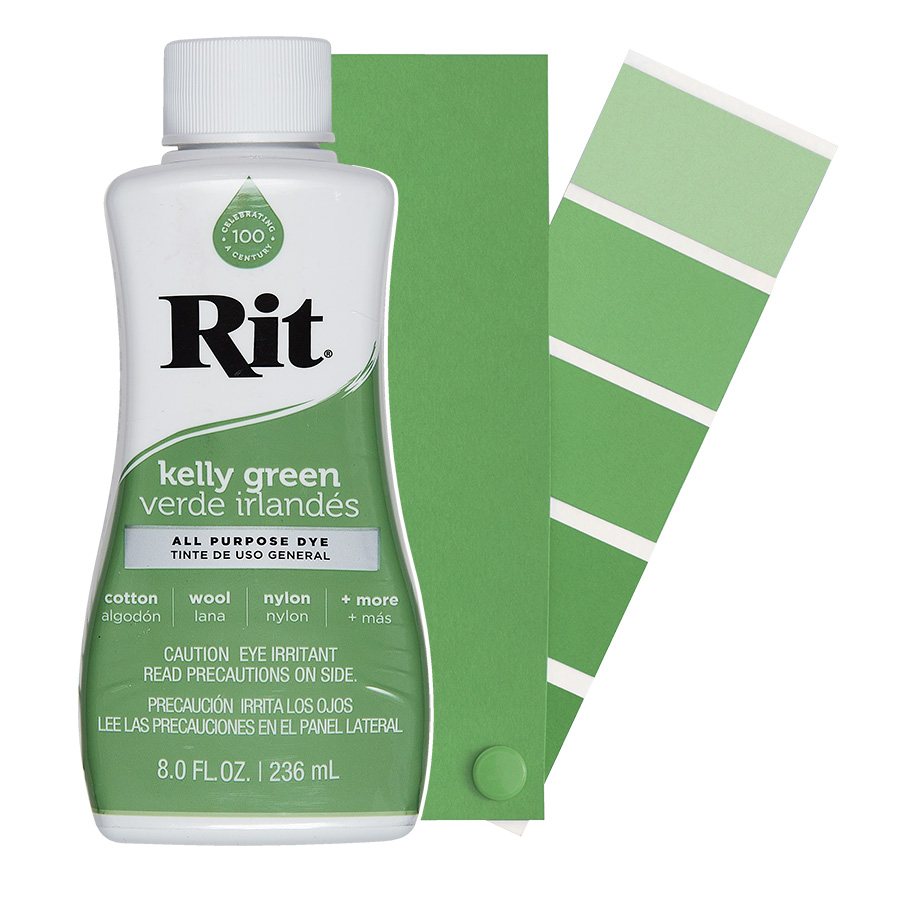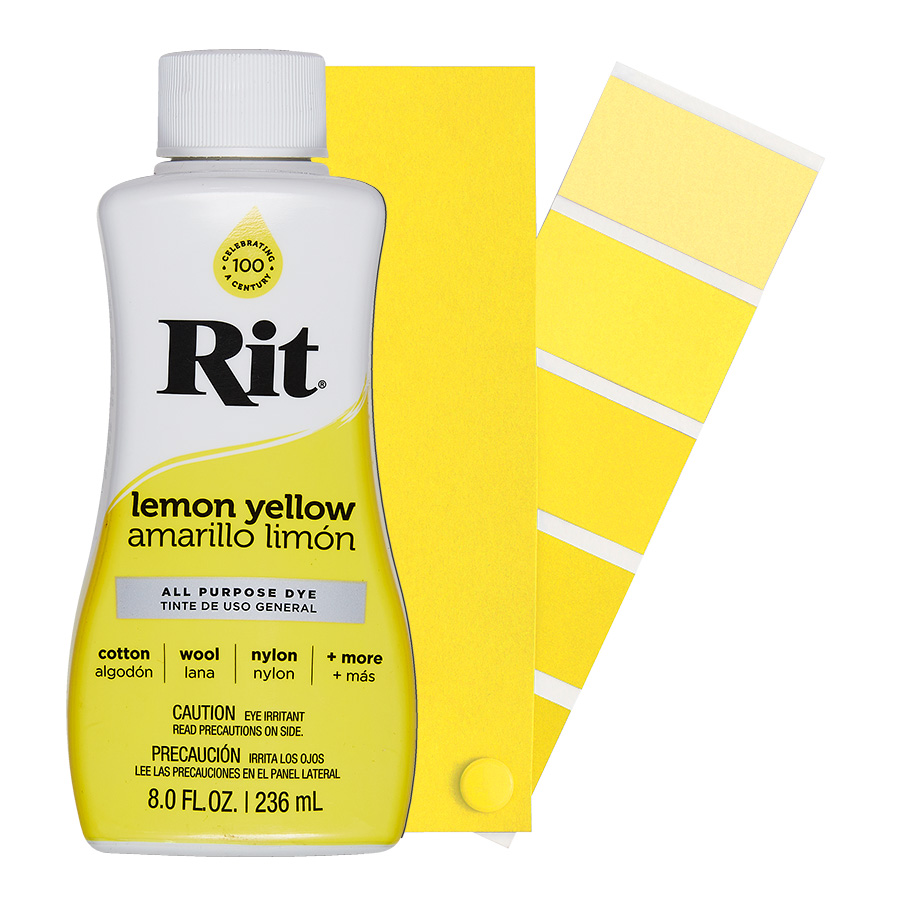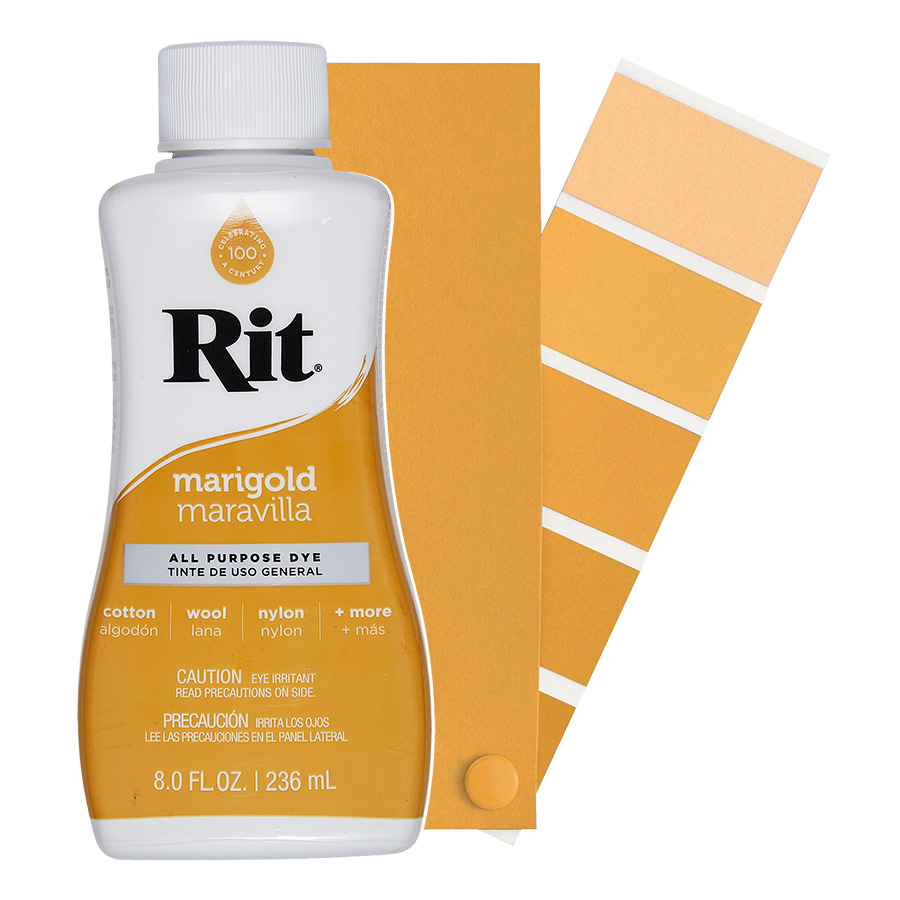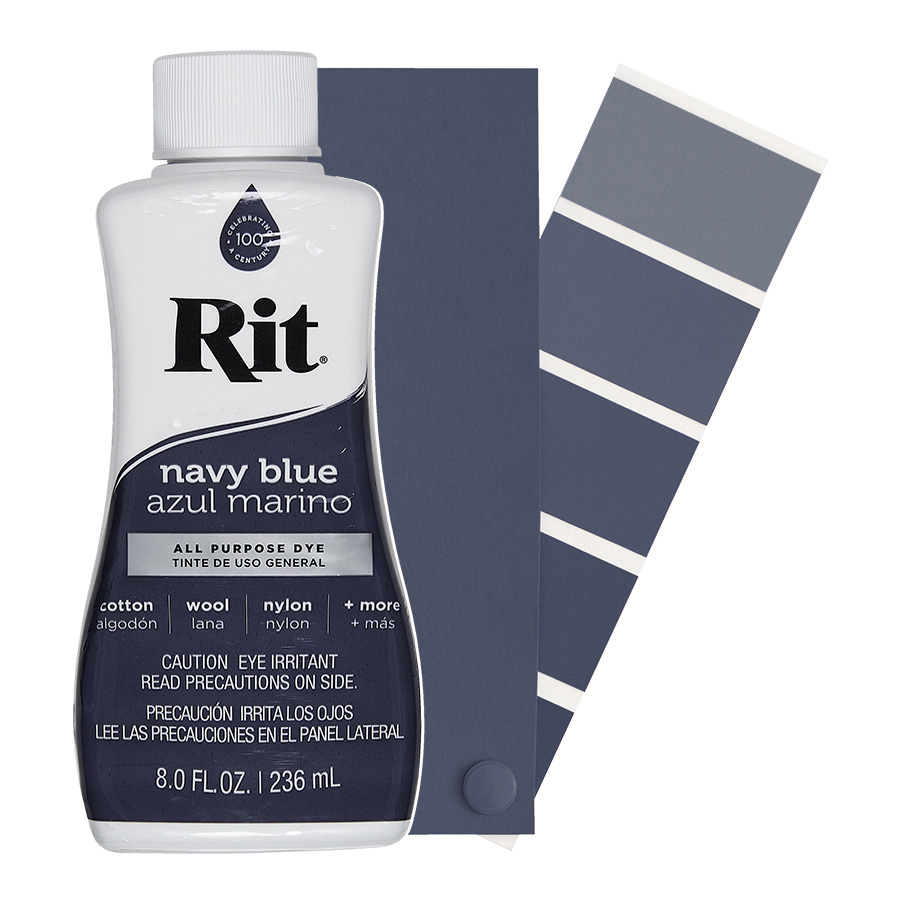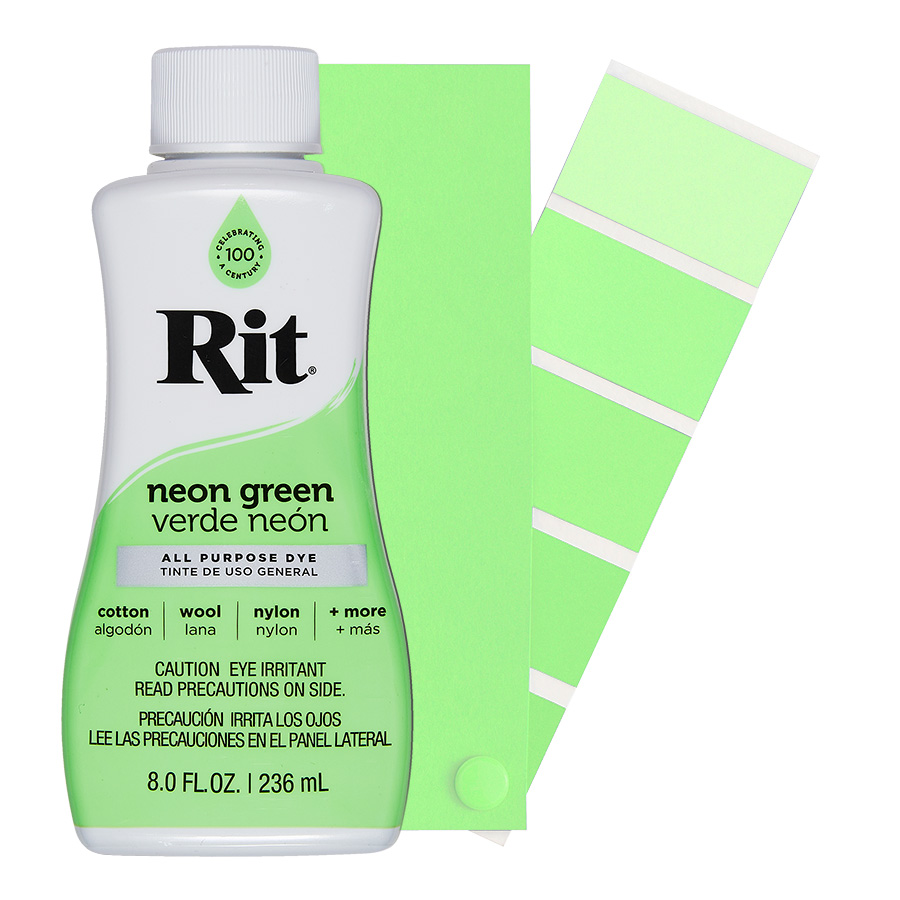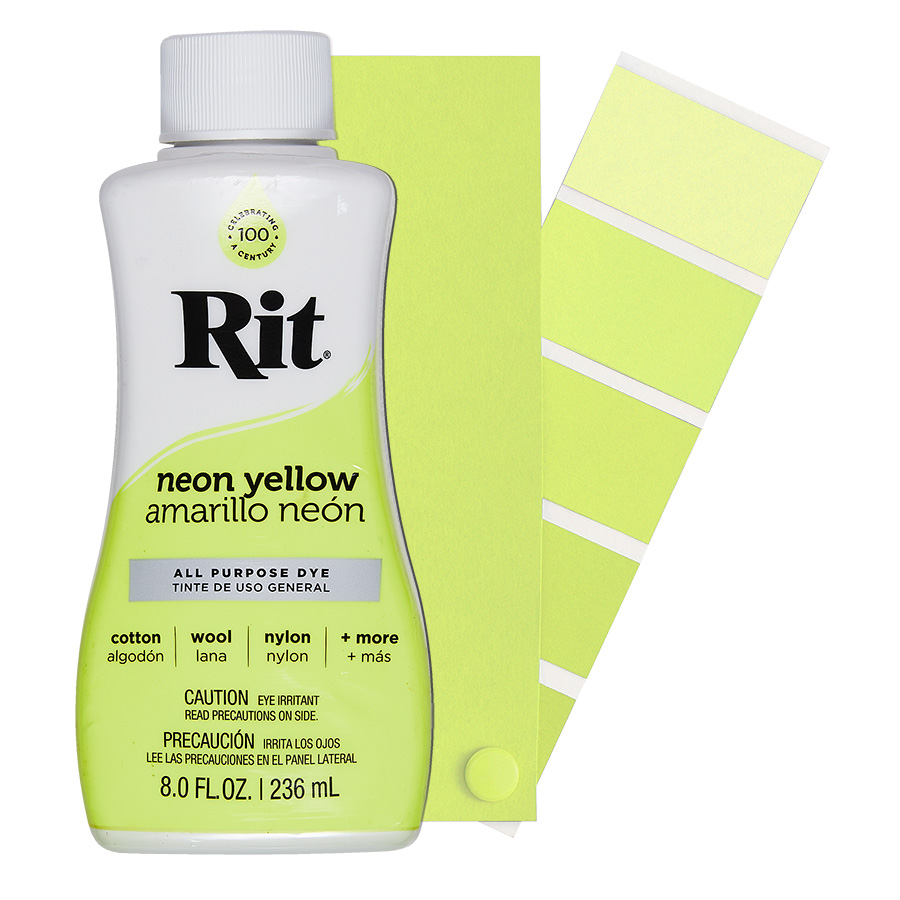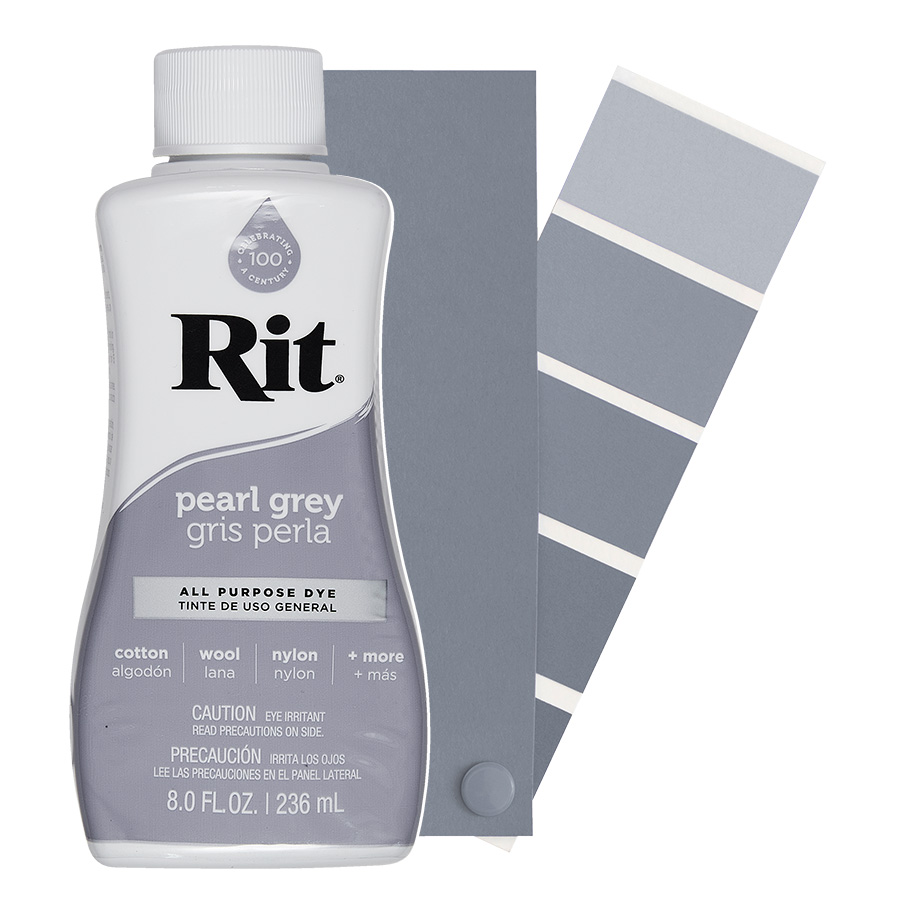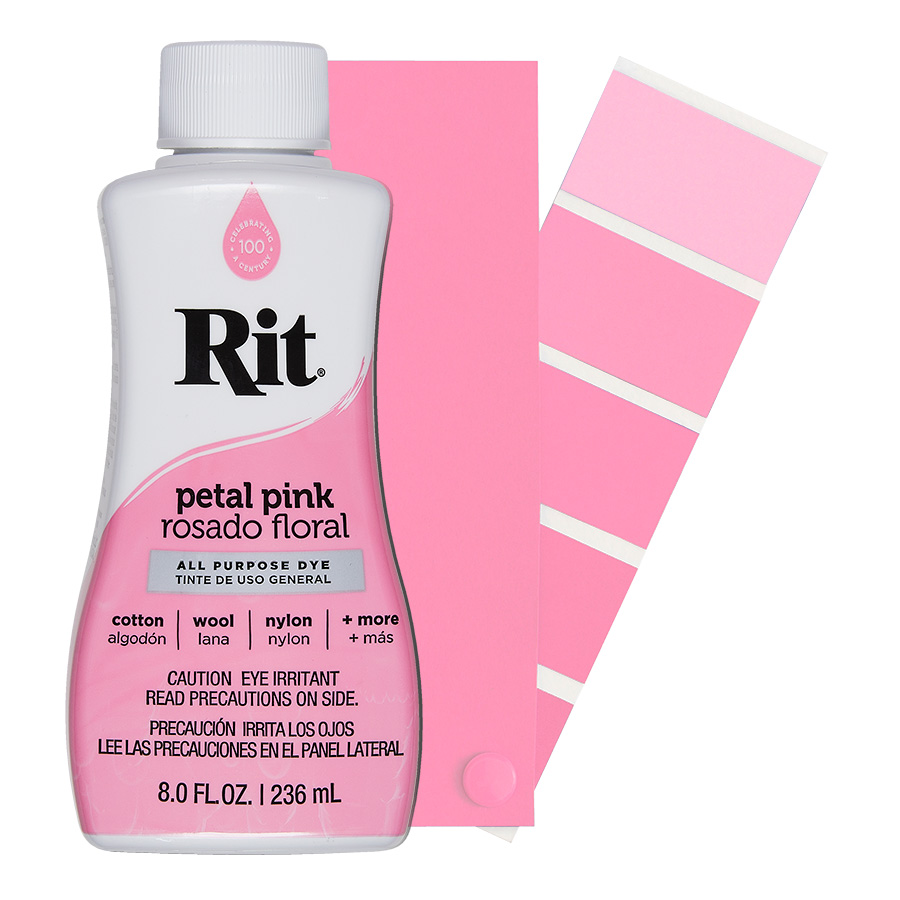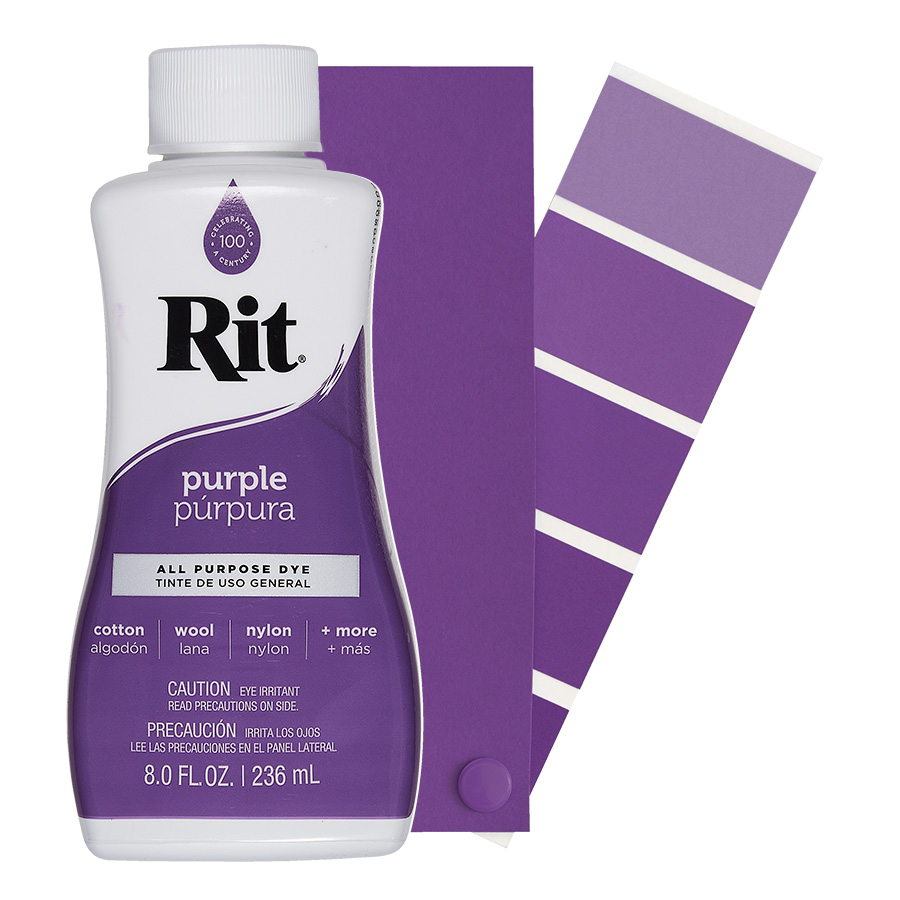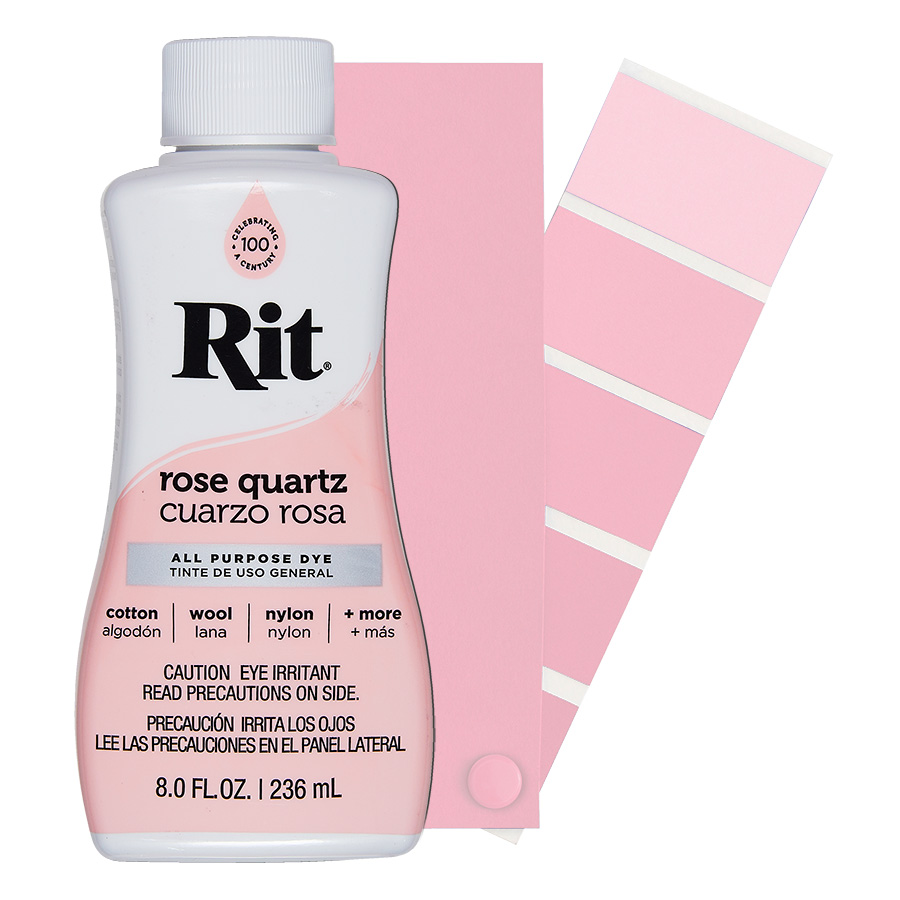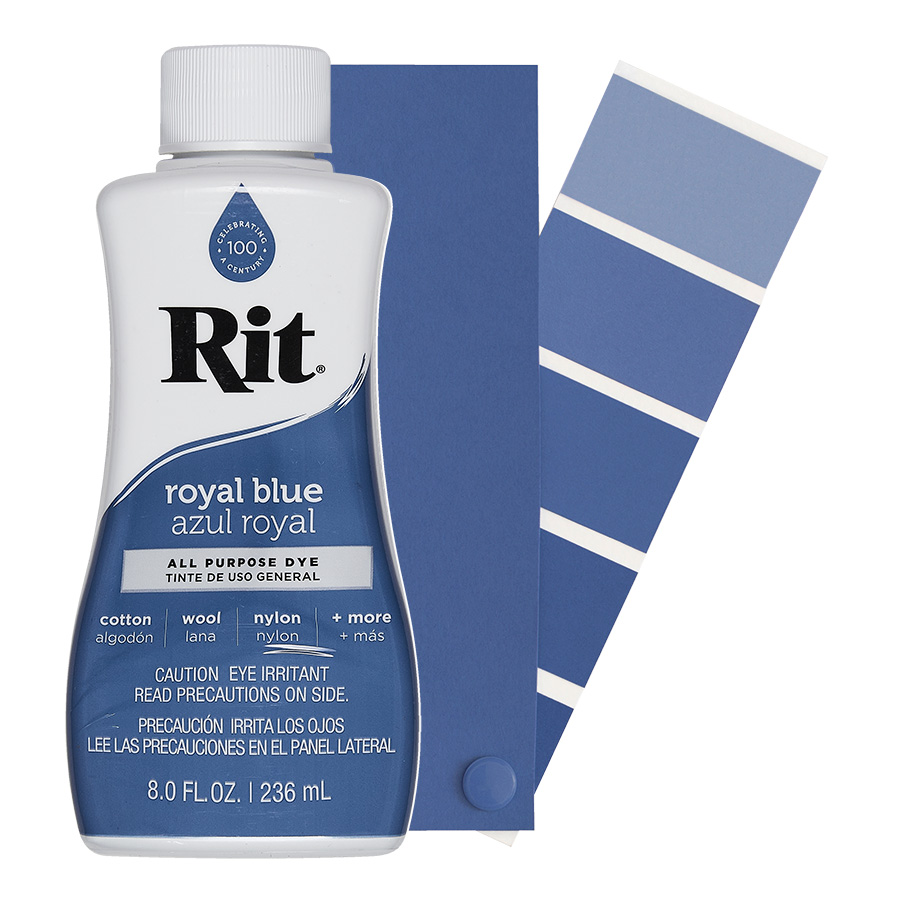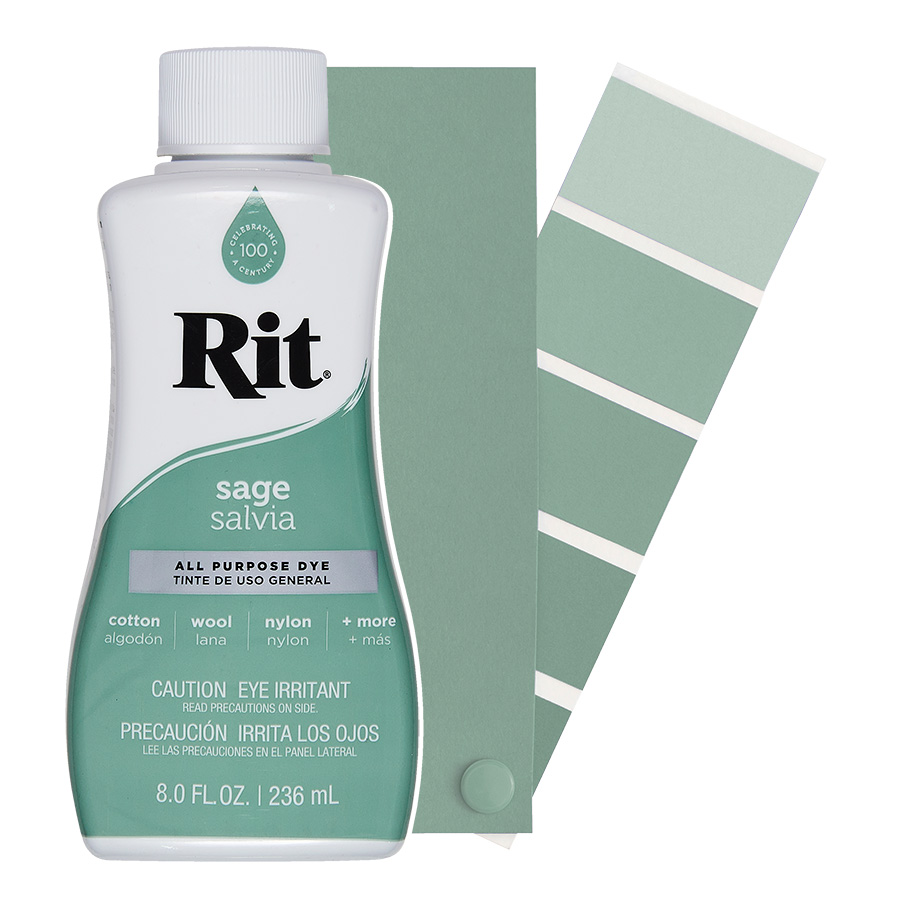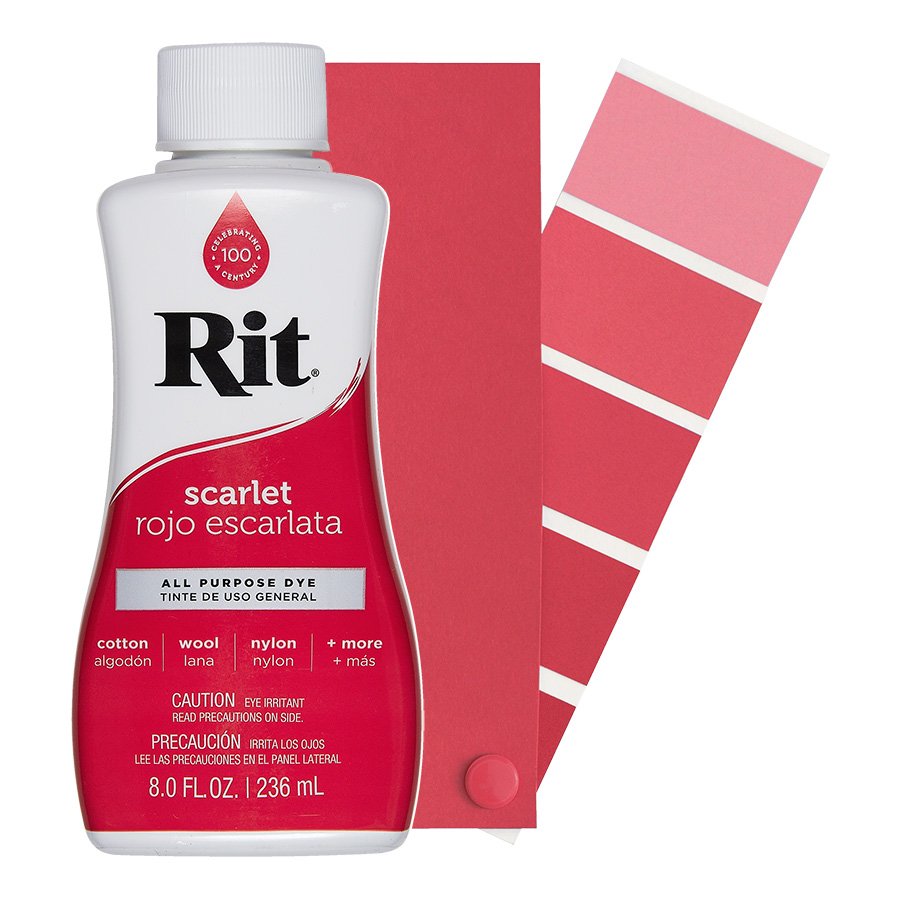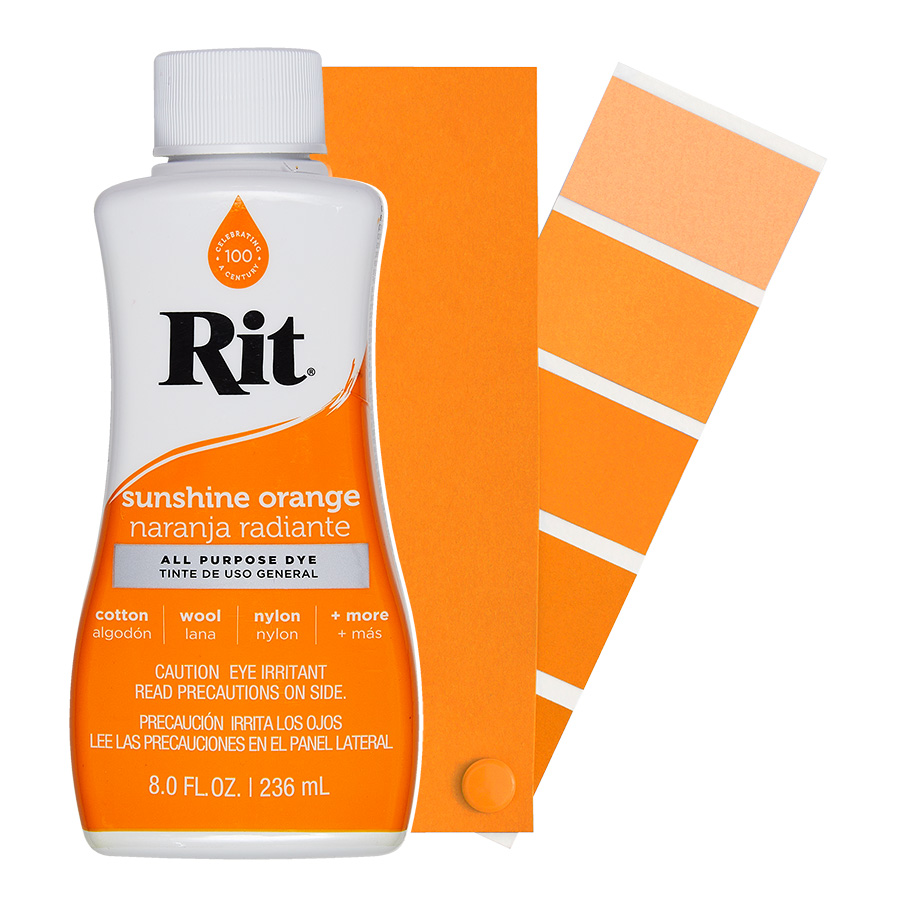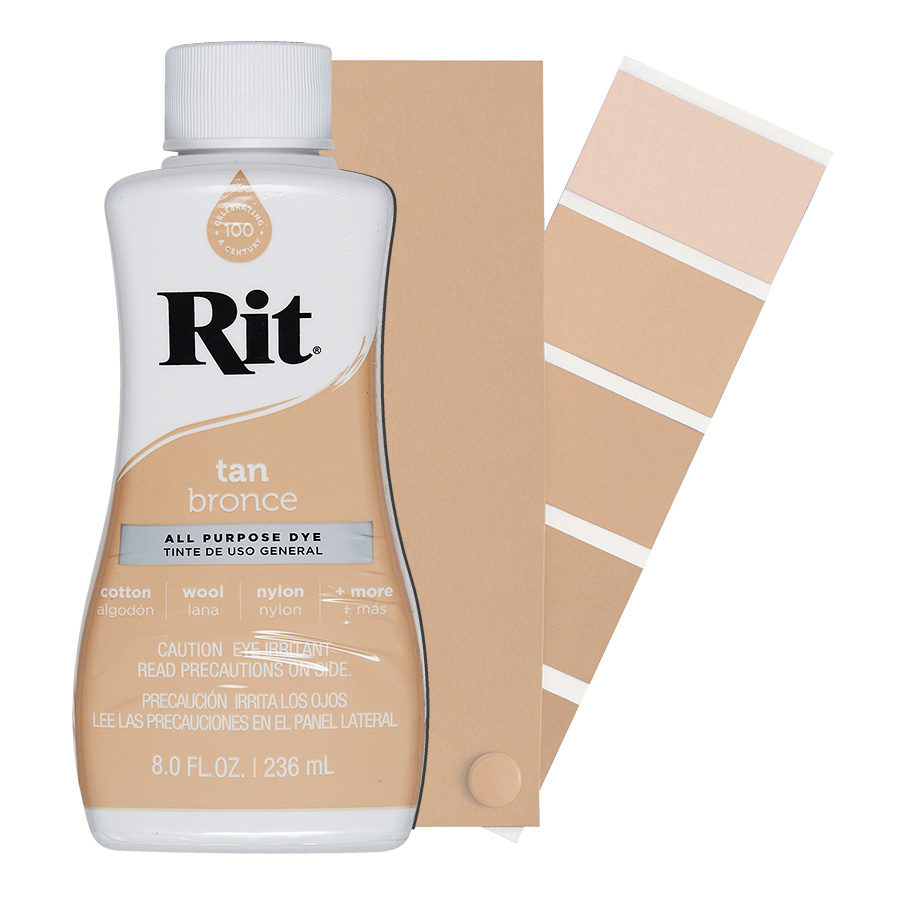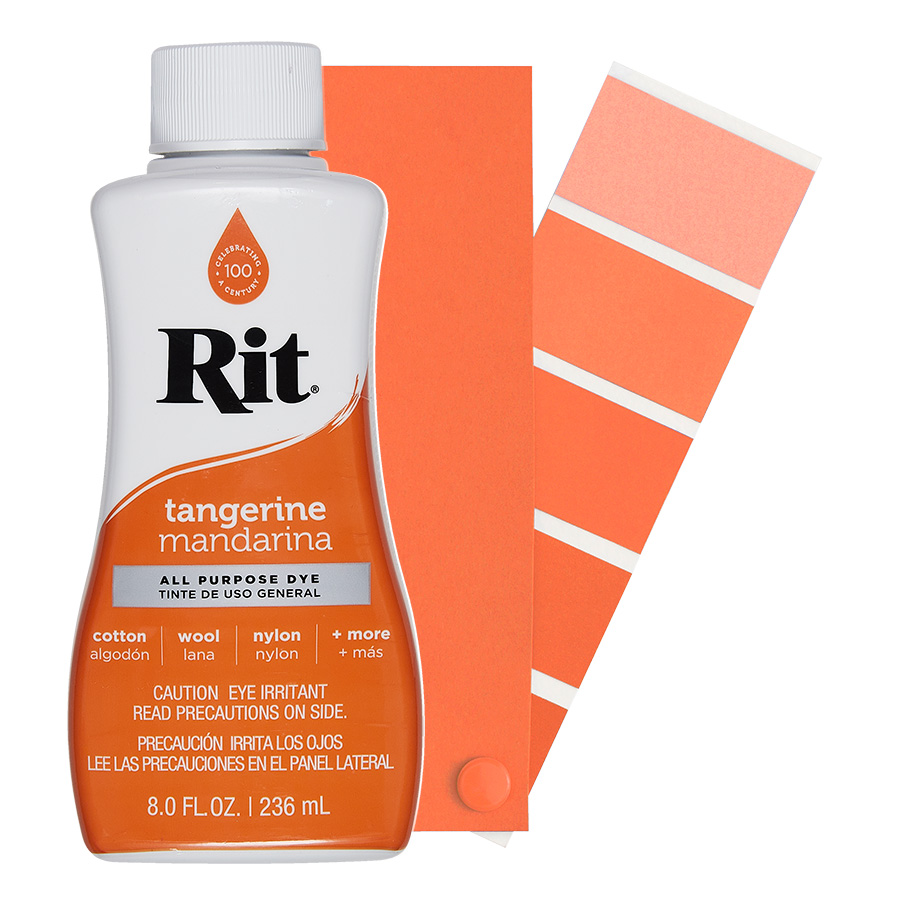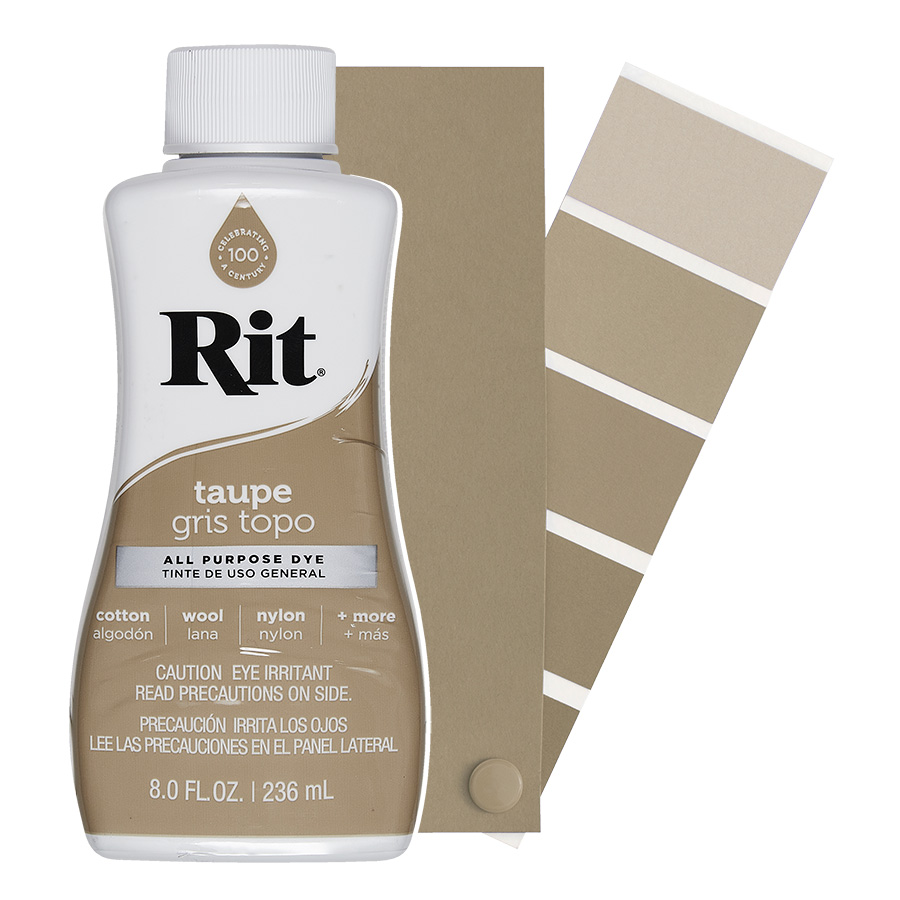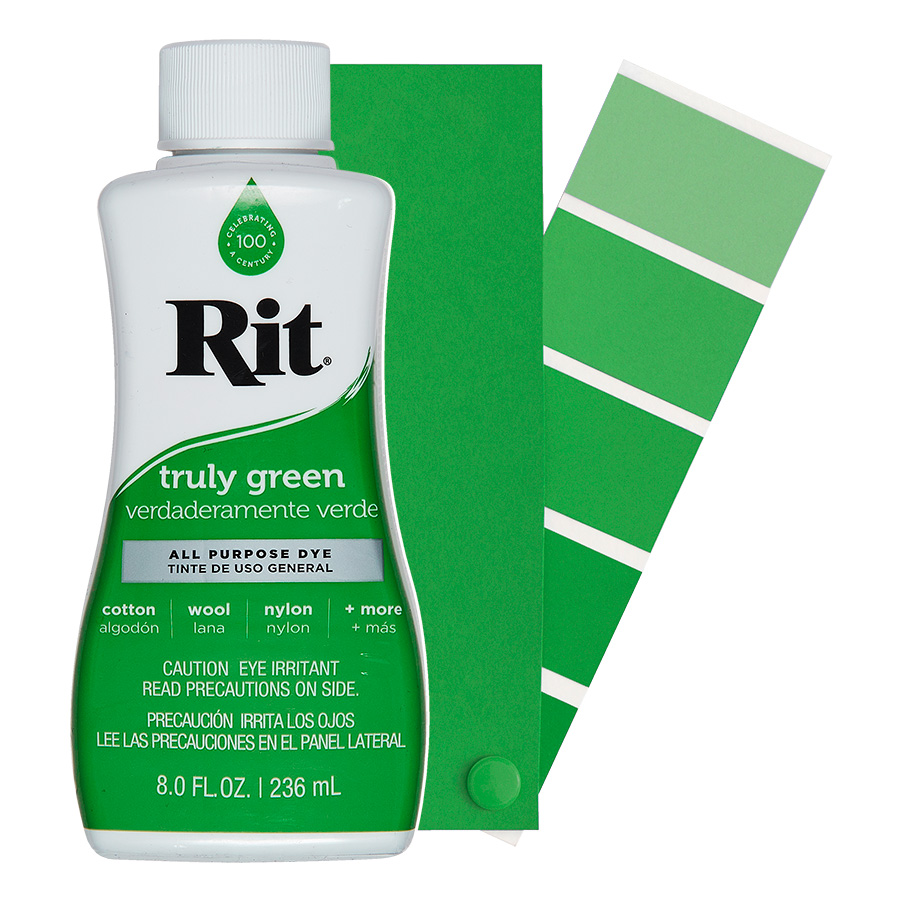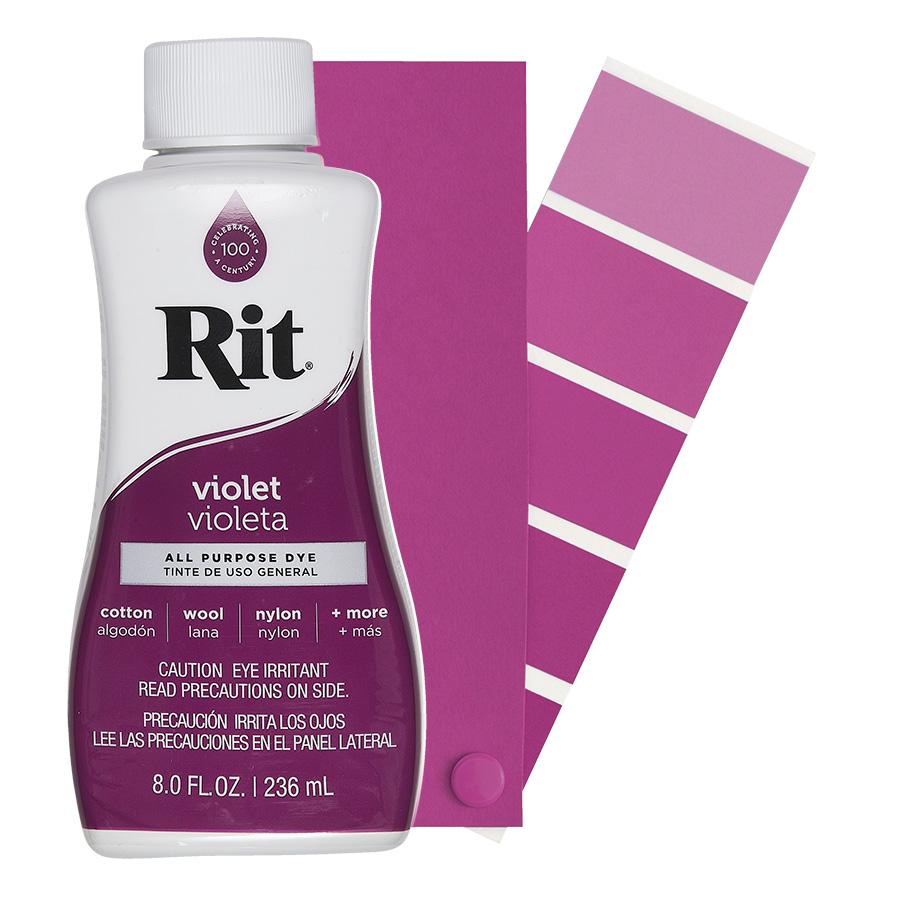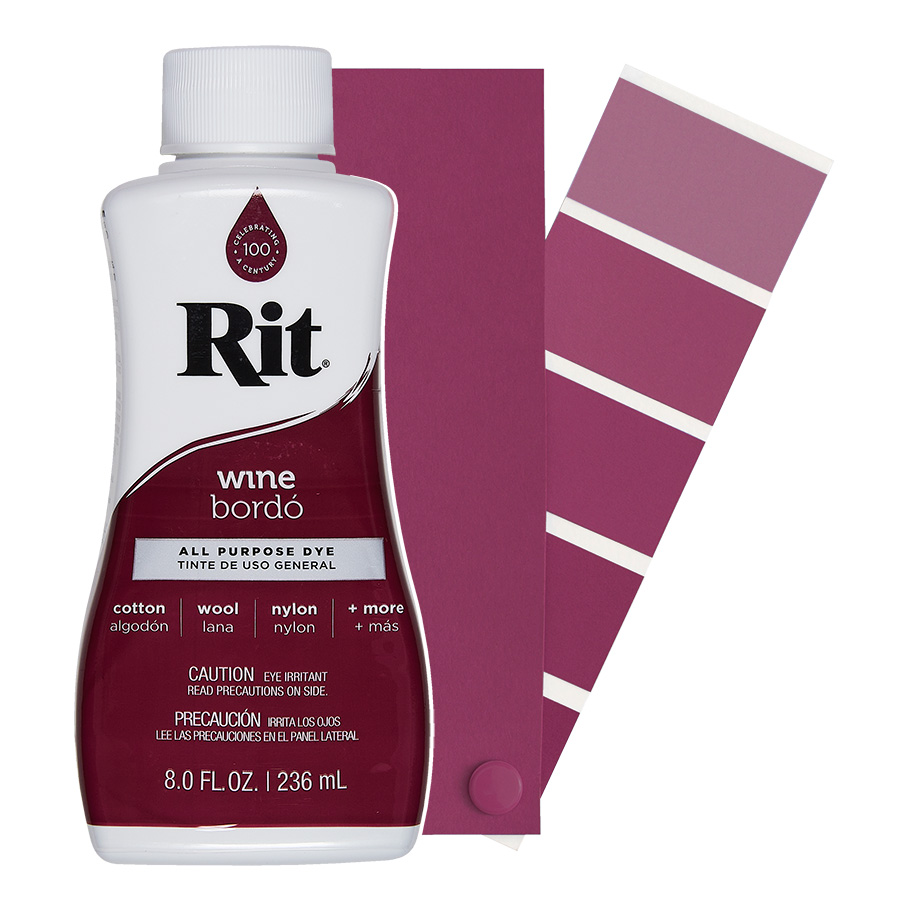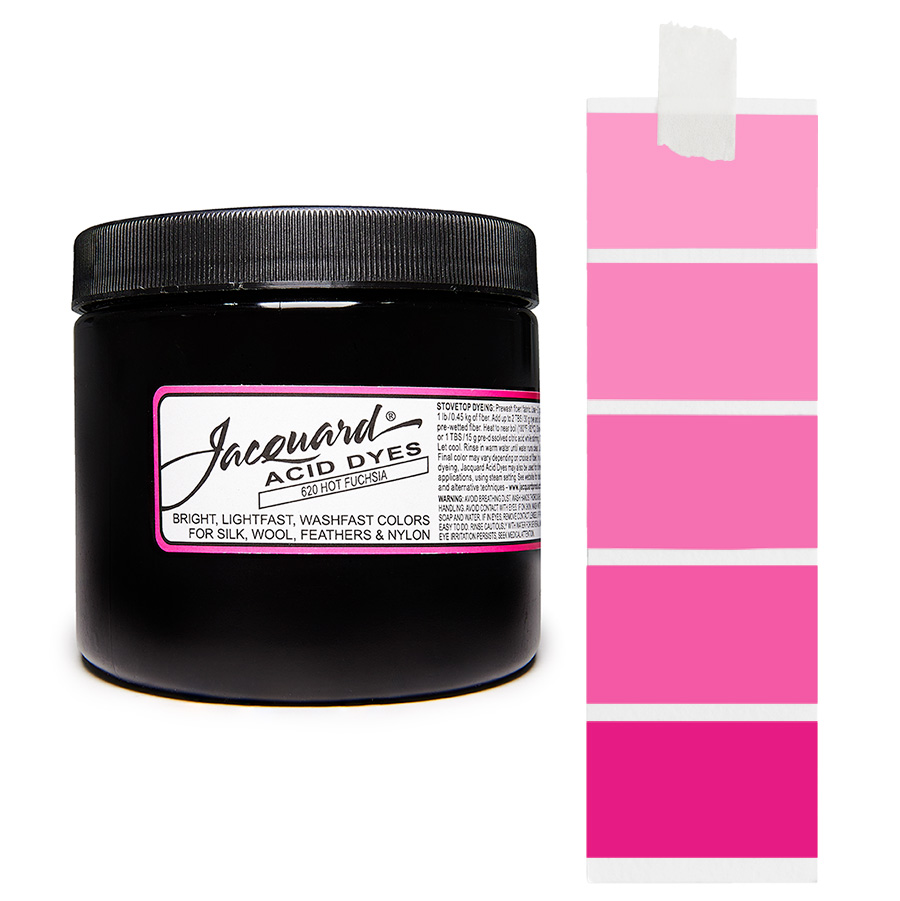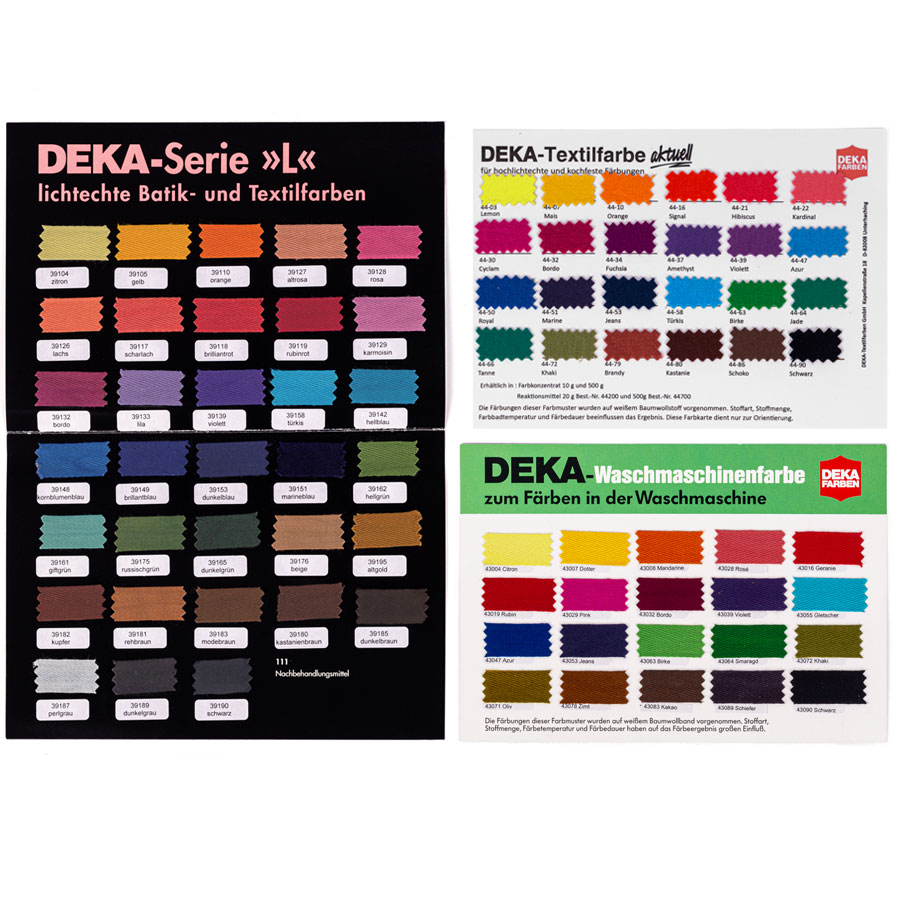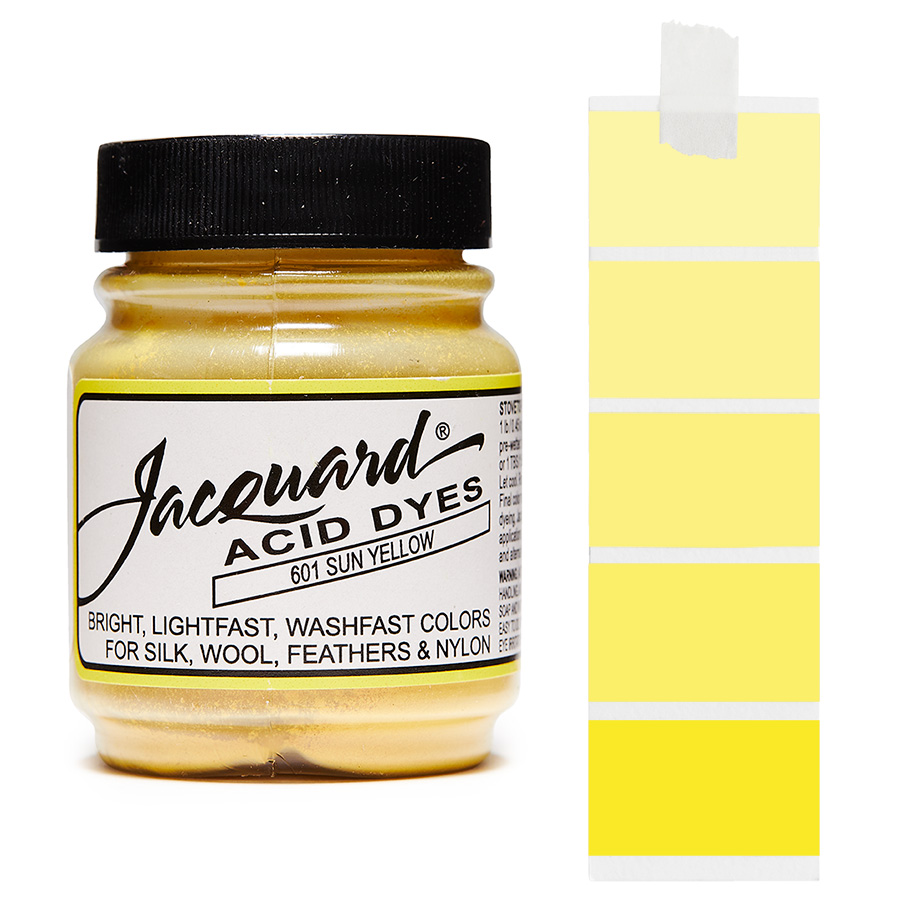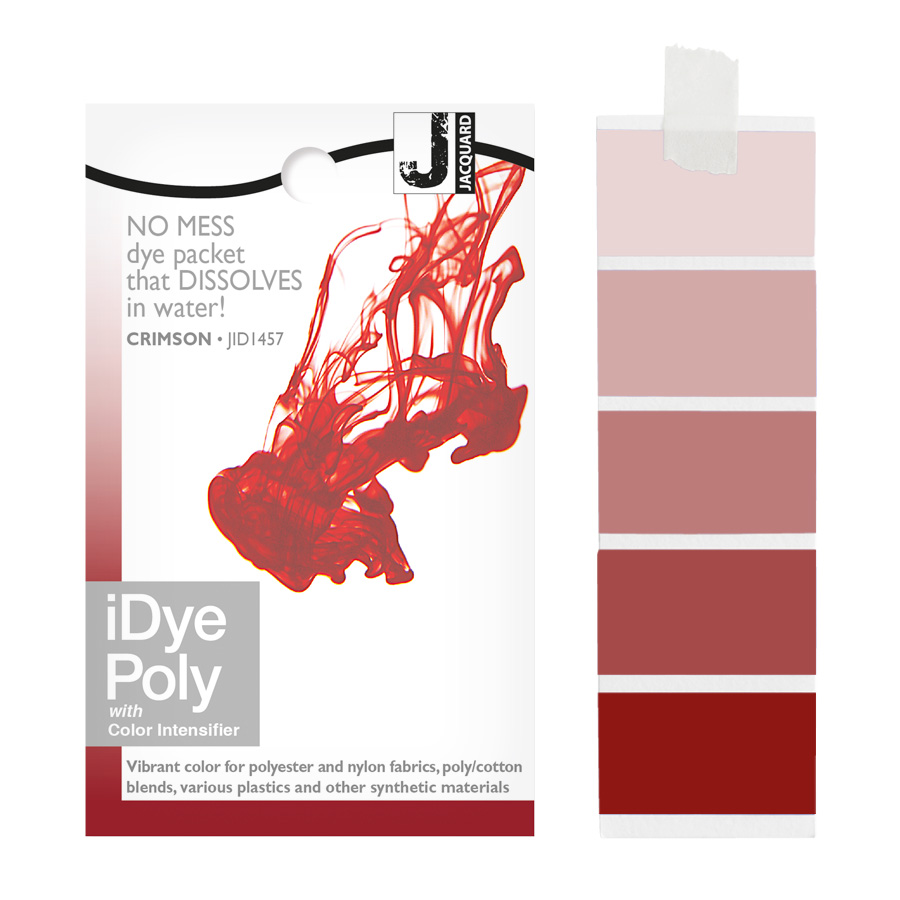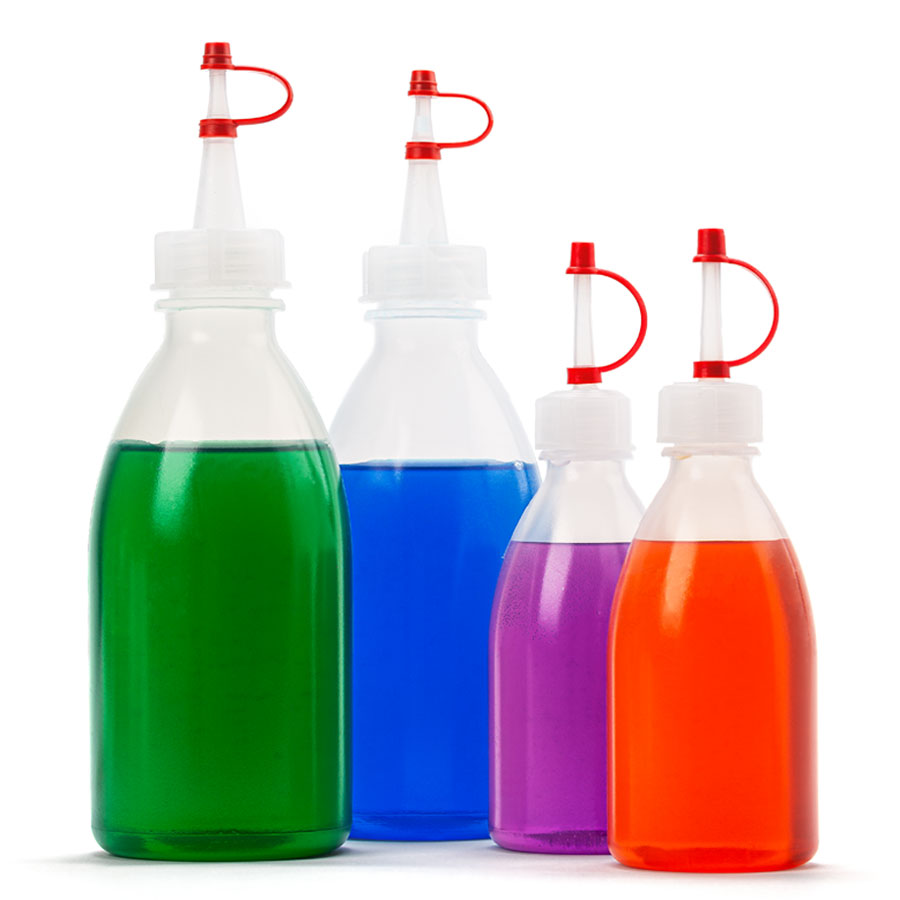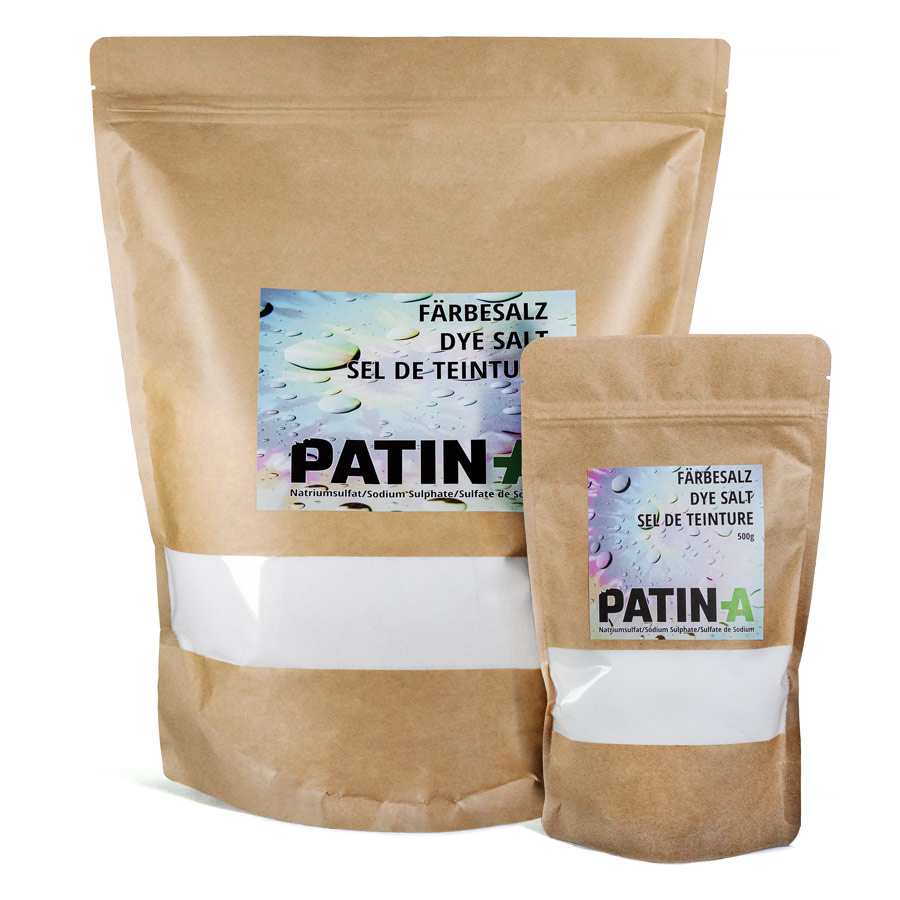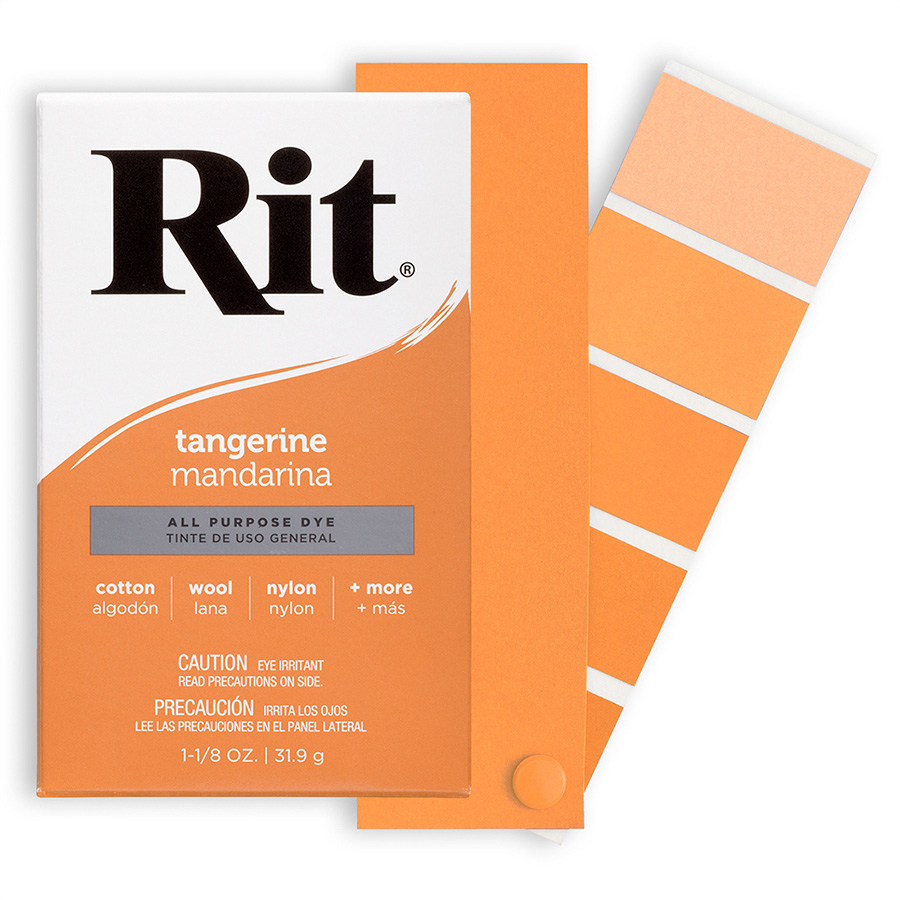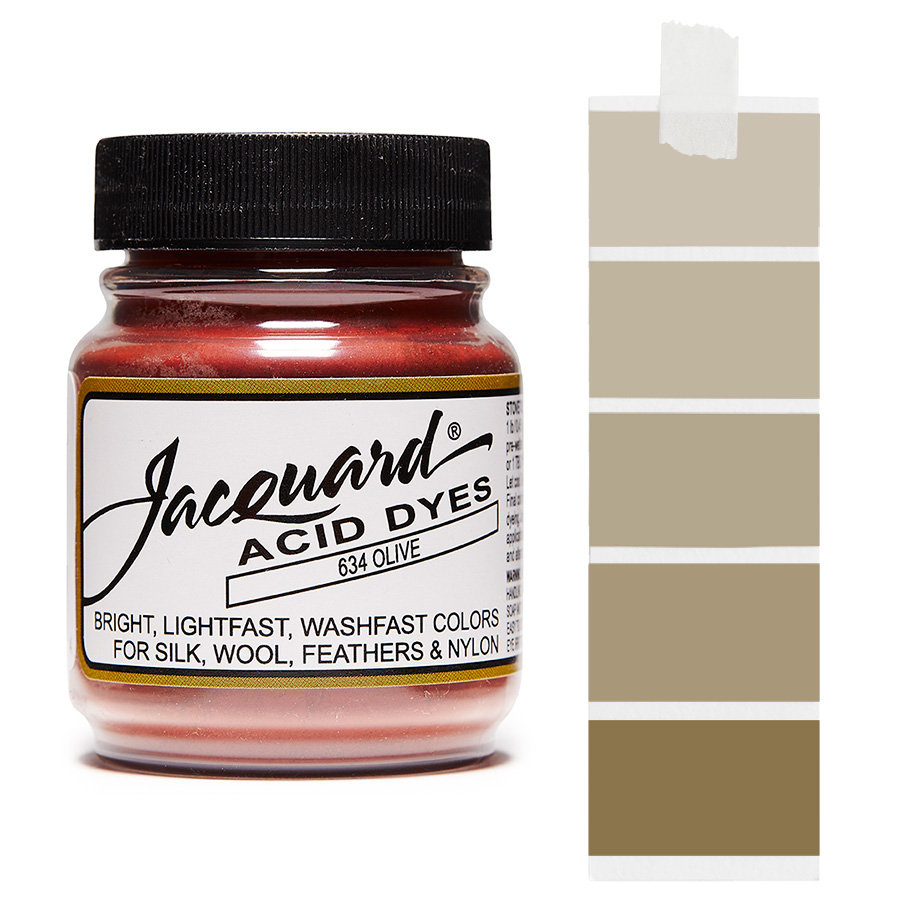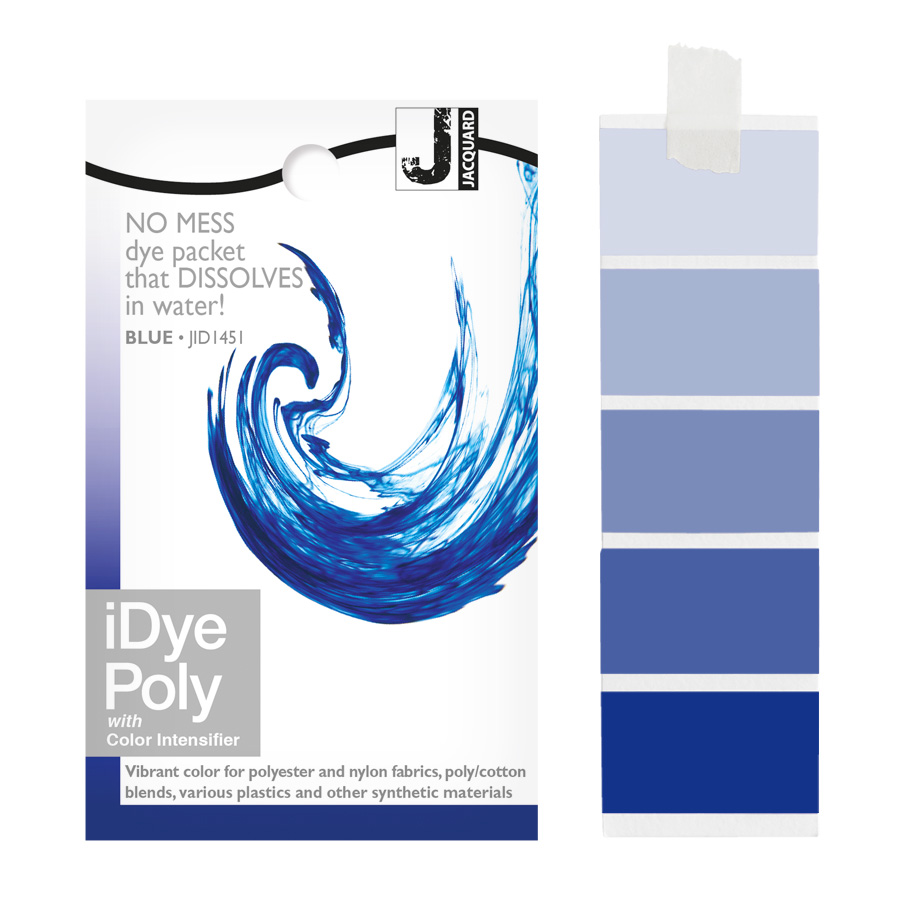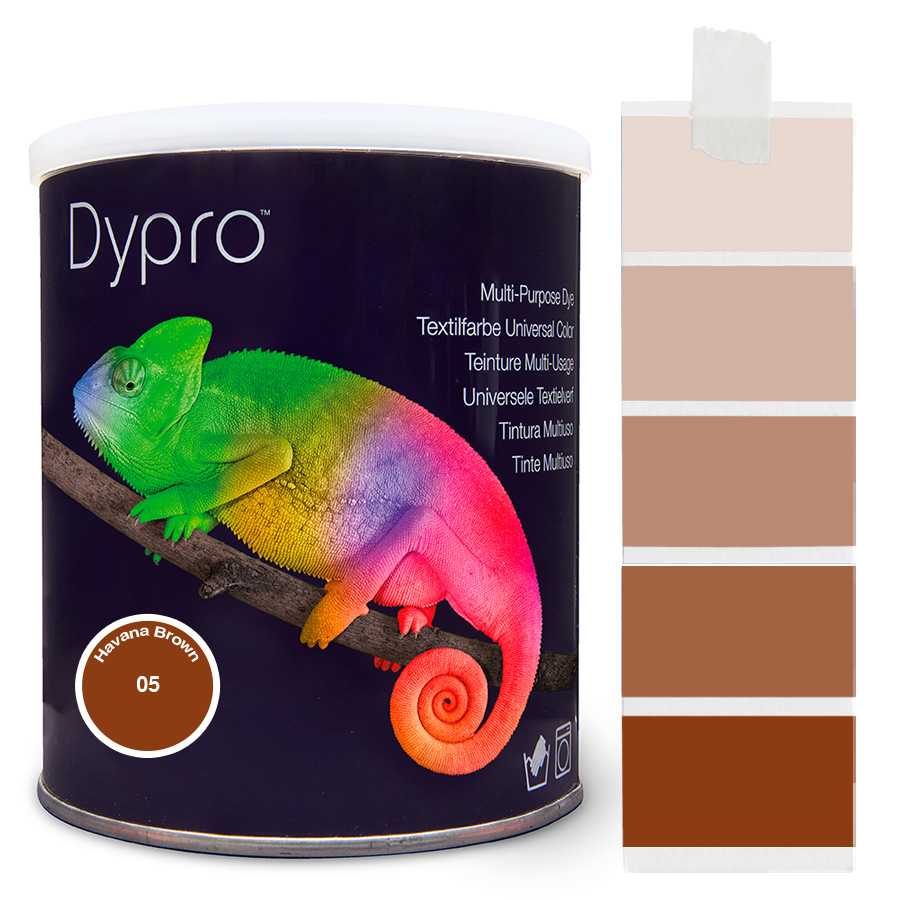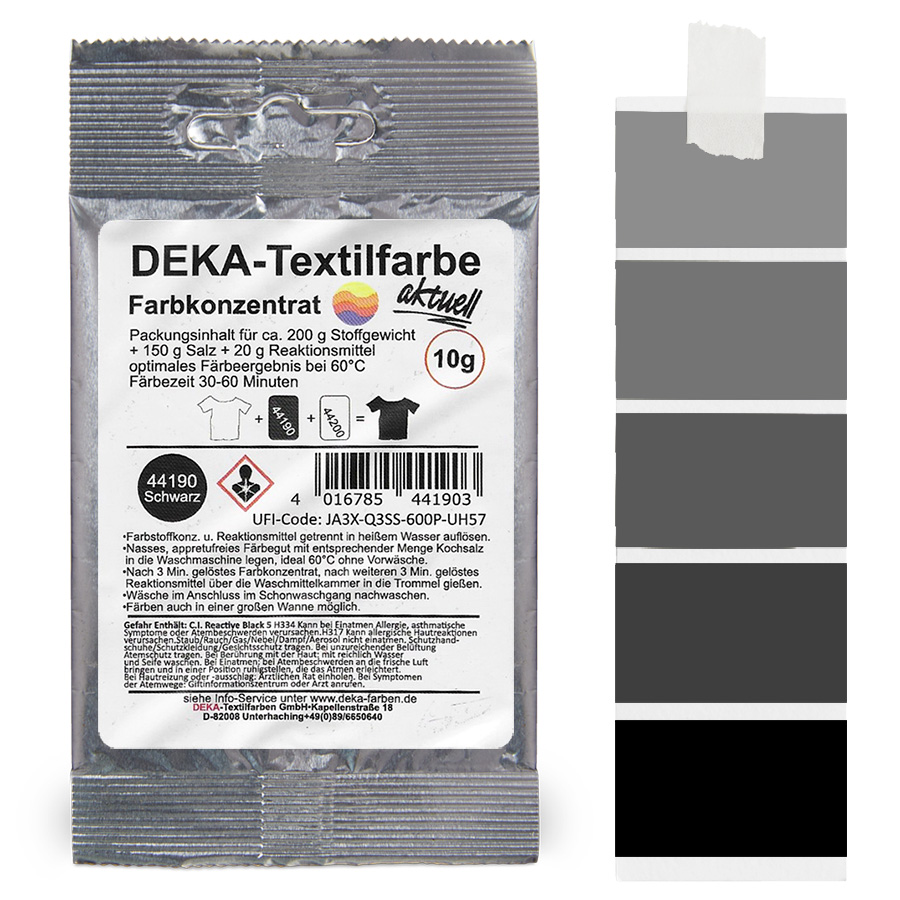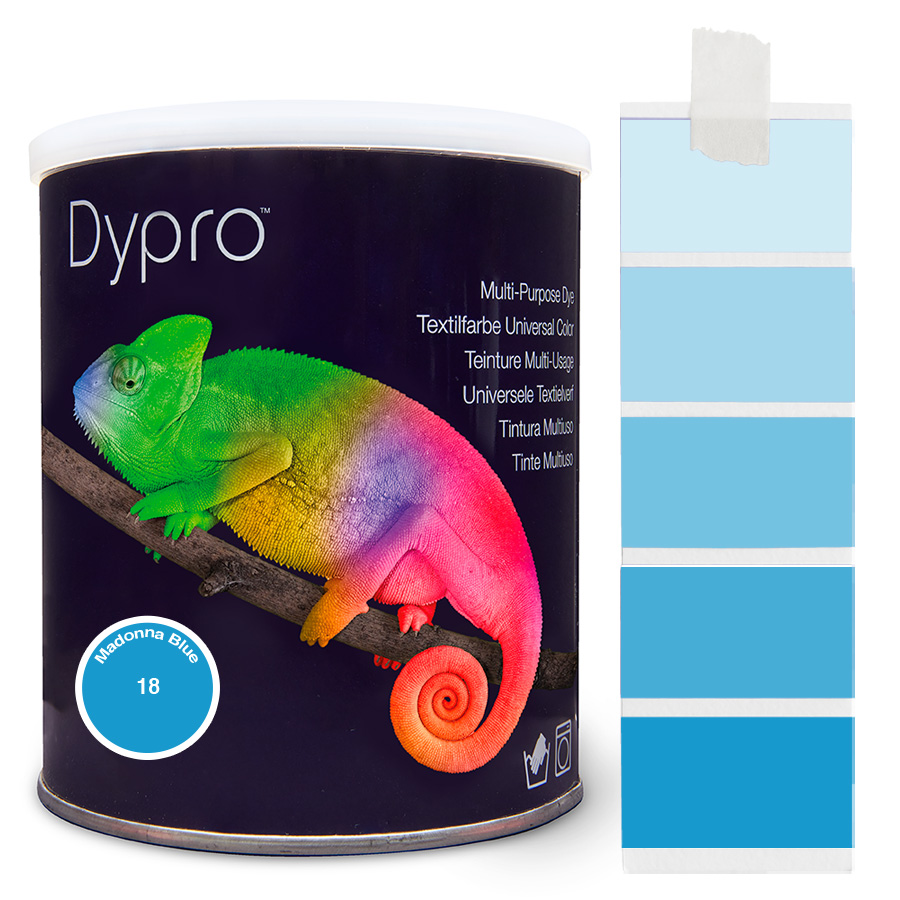Rit All-Purpose Dye - Textile Dye
Available, delivery time: 1-3 days
Easy dyeing of natural fibres, wool, silk, nylon and viscose with Rit All-Purpose Dye
Rit All-Purpose Dye has been for over 100 years one of the most popular textile dyes in the USA.
Use it to dye your old favourites or the newest acquisitions.
Rit All-Purpose Dye gives natural fabrics such as cotton, wool and silk but also synthetic fabrics such as nylon and viscose intense new colours and enhances them.
An easy, non toxic way to dye clothing, household items, 3D prints and much more the colour of your choice.
Mixed materials with less then 35% synthetic fibres can be perfectly dyed with Rit All-Purpose Dye.

Simply mix your favourite shades yourself
Rit offers a very special, unique colour mix service:
Color Formulas - thousands of colour panels in a wide range of shades.
Click on the colour of your choice, a new page opens on which you can see the exact amount of the dyes you need.
It is super easy to use as you can select the textiles to be dyed and see the exact amounts of dye and water you need.
Click here to go to the Color Formulas.
How much fabric can I dye with one bottle of Rit All-Purpose Dye?
To determine how much dye is needed, weigh the item to be dyed on a food scale or estimate the weight.
As a general guide, one bottle of Rit All-Purpose Dye will dye approximately 1 kilogram of dry fabric.
If you want to achieve a very strong colour, double the amount of dye.
Fibre content and weight influence the appearance of the dye.
If you are not sure whether your fabric will take the dye or get the desired shade we recommend testing a sample first.
What do I have to consider when dyeing?
Natural fibres can be dyed with Rit All-Purpose Dye at 60 degrees in the cooking pot or the washing machine. If you want to dye polyamide (nylon) or viscose, you need to increase the temperature to 90 degrees.
Be sure to read the dye instructions before dyeing! This will help you avoid gross mistakes and a bad dyeing result.
To dye textile fibres you need high temperatures.
Please forget about the manufacturer's recommendations on the label in the garment! Cotton and linen tolerate a boil wash without any problems - just like polyester or polyamide (nylon).
Don't be afraid - dyeing in a cooking pot is very easy.
High spin rates and tumble drying are more problematic. This is what causes garments to shrink. Not a hot wash!
Dyeing in the washing machine?
Dyeing in a washing machine is the most convenient dyeing method of all. All you have to do is sit back, relax and let your machine do all the work.
If you have never used dye in a washing machine before, we understand why you are nervous!
Who wants a purple washing machine?
Well, we might ;-). Nevertheless, we can promise you that Rit will not permanently discolour any metal parts in your washing machine.
Rit has been used in washing machines for decades, ever since the invention of the electric washing machine in the 1950s.
In the early 60s, Rit coined the phrase "Push Button Color!", to promote the connection between Rit and washing machines.
Rit even launched liquid dye to make it easier to use Rit in your machine.
With so much history, you can be sure that your washing machine will remain stain free for decades to come.
Very important: Be sure to clean all plastic parts of your washing machine immediately after dyeing. You can also easily remove the detergent compartment and clean it with household cleaner.
Dye salt or vinegar?
• Salt is needed for dyeing cotton, linen, ramie, rayon.
• Vinegar is needed for dyeing nylon, silk, wool.
Fixing after dyeing?
After dyeing and before rinsing, all natural fibres or fabric blends should be fixed. That's what the easy-to-use Rit ColorStay Dye Fixative is for.
Polyamide (nylon) does not have to be fixed.
Dye instructions
• Dye instructions for pot dyeing: Instructions Pot Dyeing
• Dye instructions for washing machine dyeing: Instructions Washing Machine Dyeing
Recommendation:
• 1 tea spoon Synthrapol or washing up liquid (takes surface tension) for pot dyeing.
• Please protect yourself with rubber gloves.
Content:
236 ml / 8 oz. liquid textile dye
Selling unit: 1 piece
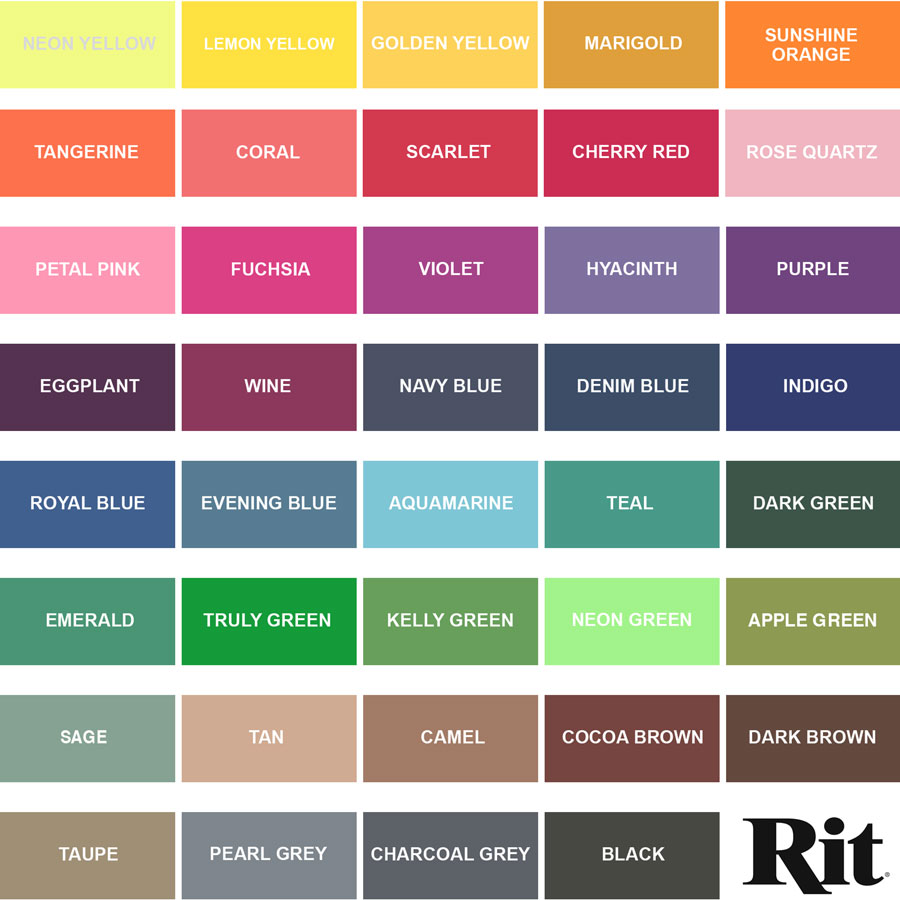
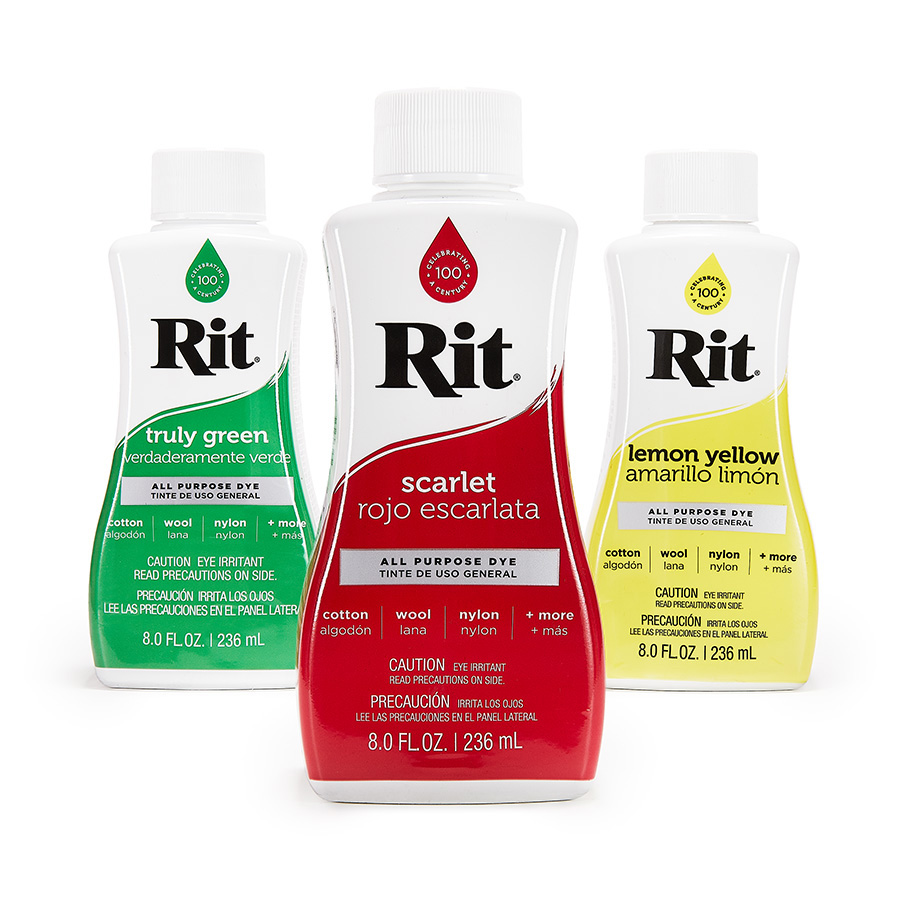
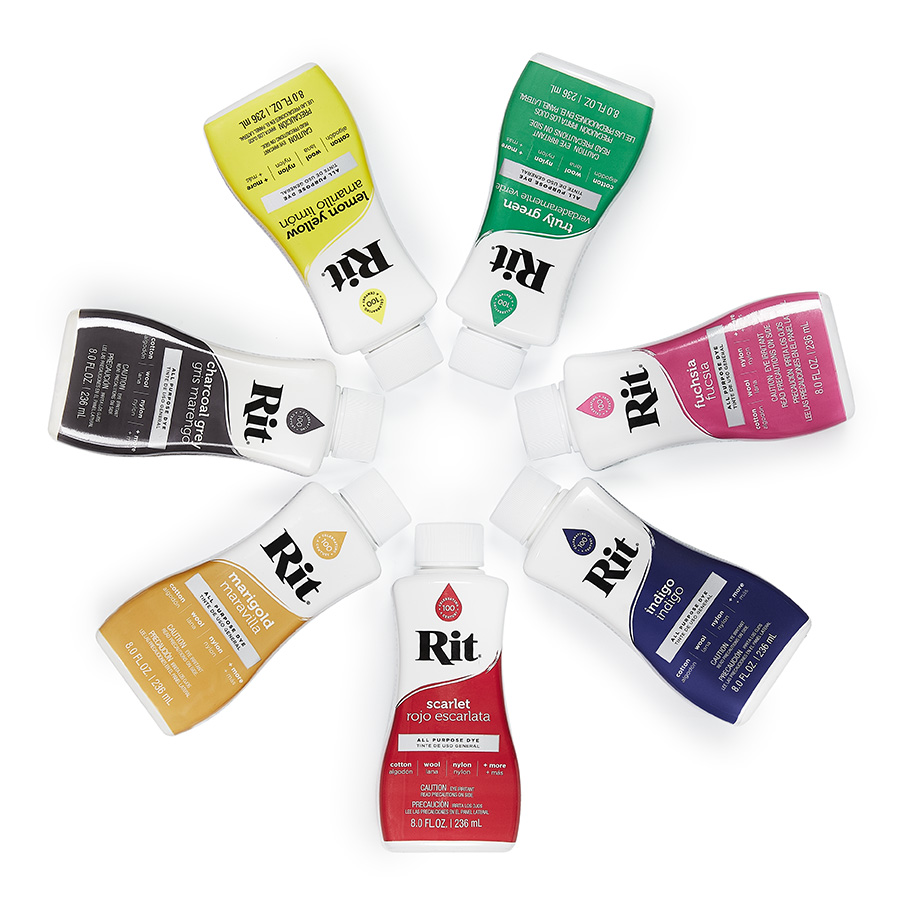
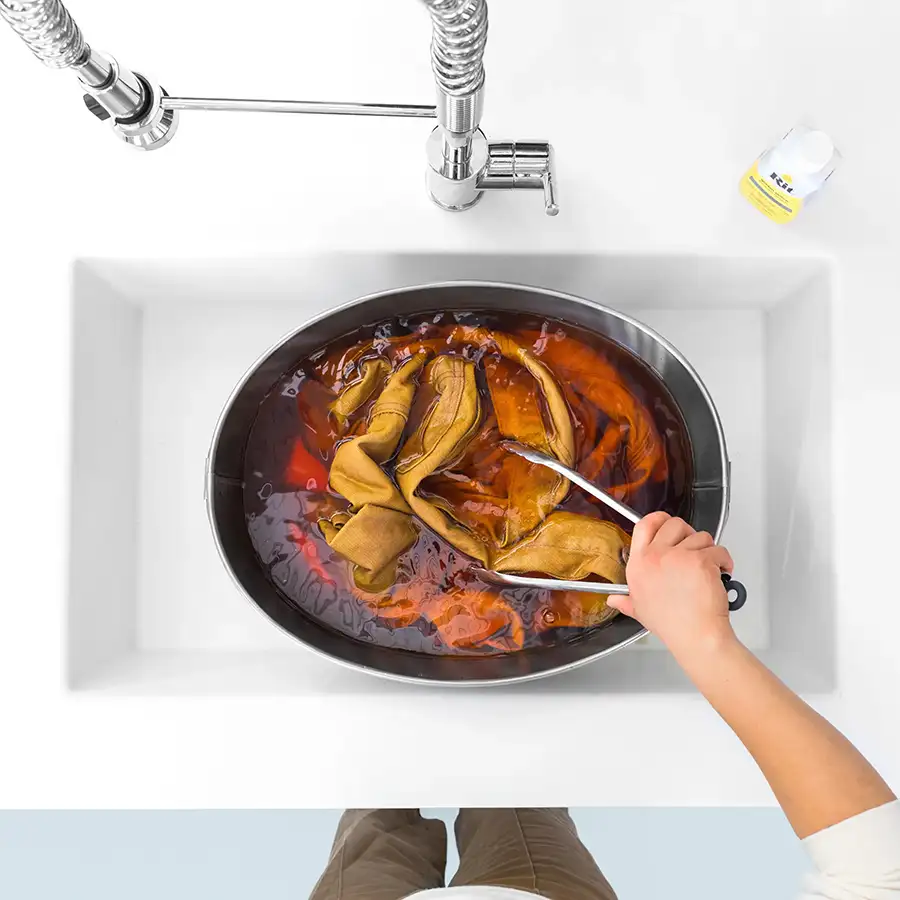
Rit All-Purpose Dye - Instructions
– This versatile dye is ideal for almost any task on your to-do list. Each little packet is colourful and ready to add a personalised touch to new and old garments, household items and much more.
– No matter what you want to dye, whether a pair of jeans or a curtain, the first step is to choose the right dye for your fabric or material. Always check the care label for the fibre content of the fabric you want to dye.
– This dye is suitable for natural fabrics such as cotton, linen, wool, silk and ramie. It also dyes viscose and nylon. If the garment you want to dye contains more than 35 % synthetic material (such as polyester, acrylic or acetate), you must instead use Rit DyeMore Synthetic Fiber Dye.
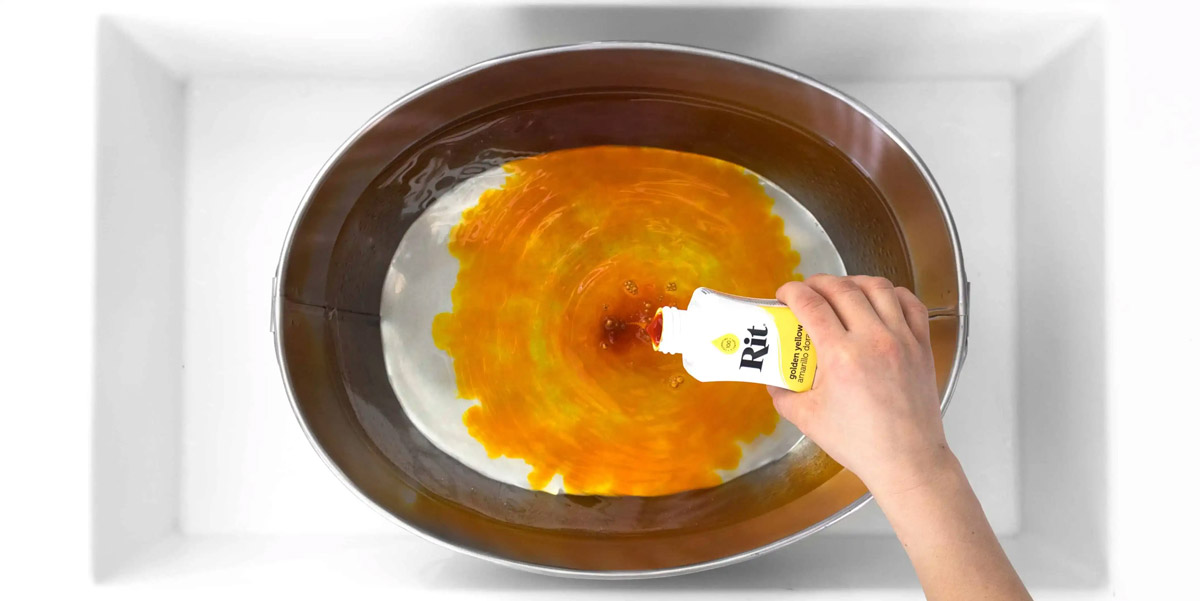
Important tips
Colour
If the garment to be dyed is white or off-white, you should be able to reach the desired colour. If the garment is already dyed, please read our instructions for changing the colour of a garment.
Patches and logos
If the garment to be dyed has a pattern or a logo, the dye used will mix with the existing colours in the fabric and create new colours. If you want to know more about this, please read our instructions for over-dyeing of patterns and logos.
Bleach stains and sun damage
The sun and bleach damage the fabric, making dyeing very difficult. If you still want to dye a garment with bleach or sun damage you can try treating the garment with Rit Color Remover before dyeing. Unfortunately, we cannot guarantee that this will work.
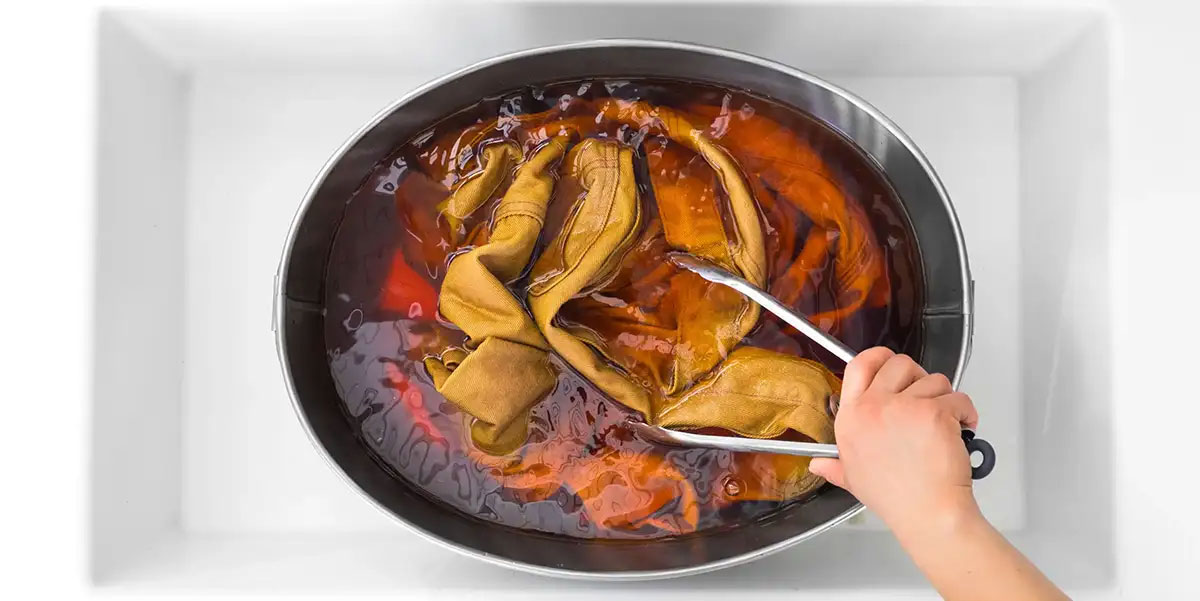
Choose your dye method:
• For general dyeing projects, use the wash basin or bucket method.
• If you want to achieve the most vibrant colours possible (or dye nylon), use the stove or cooking pot method.
• If you want to dye big objects or are looking for the easiest dye method, use the washing machine method.
1. Sink or bucket dye:
Materials needed :
• Rit All Purpose Dye
• Rit ColorStay Dye Fixative (recommended)
• Measuring jug
• Big spoon
• Plastic container or stainless steel sink
• Paper towels
• Rubber gloves
• Dye salt or kitchen salt (for dyeing cotton, viscose, ramie or linen)
• Vinegar (for dyeing nylon, silk or wool)
• Washing up liquid or Synthrapol
Instructions
1. To determine how much dye is needed, weigh the item to be dyed on a food scale or estimate the weight. As a general guide, one bottle of Rit All-Purpose Dye will dye approximately 1 kilogram of dry fabric. If you want to achieve a very strong colour, double the amount of dye.
2. Fibre content and weight influence the appearance of the dye. If you are not sure whether your fabric will take the dye or get the desired shade we recommend testing a sample first.
3. Before dyeing, remove all visible stains from the garment. This way, you will achieve consistent colour results when dyeing. Pre-wash the garment in warm soapy water without softener. This will remove any finishes that may interfere with dye absorption.
4. Cover the work area with a plastic tablecloth and have paper towels ready to prevent any stains.
5. Wear rubber gloves to protect your hands from stains and burns.
6. Fill a plastic container or a stainless steel sink with enough water to allow the fabric to move freely. We recommend approx. 10 l of water per 1/2 kilogram of fabric.
The water should ideally have a temperature of 60 °C. If water from the tap is not hot enough, heat it on the stove and add it to the dye bath.
7. To intensify the colour:
(1) 250 g of salt when dyeing fabrics with cotton, rayon, ramie or linen;
(2) 250 ml of vinegar when dyeing fabrics with nylon, silk or wool.
8. Add 1 teaspoon Synthrapol or washing up liquid to help ensure even dyeing.
9. Add well shaken liquid dye to the dye bath and mix well.
10. Test the colour by dipping a paper towel into the dye bath. If the colour is too light, add more dye. If the colour is too dark, add more water.
11. Wet the fabric, squeeze out excess water and add to the dye bath.
12. Stir slowly and continuously. The first 10 minutes are the most critical. Stirring helps to make the colour even and to avoid stains.
13. The piece can stay for 10 minutes to an hour in the dye bath while stirring. If you are dyeing a polyester-cotton blend, leave the fabric for at least 30 minutes in the dye bath so that the dye is fully absorbed. Nylon tends to dye very quickly and much darker than other fibres, so that the actual time needed in the dye bath is less.
14. When the desired colour is reached, take the piece out of the dye bath. The fabric looks darker when wet and becomes lighter when dry.
15. To intensify the colour and reduce colour bleeding, immediately after dyeing and before washing use Rit ColorStay Dye Fixative and follow the instructions.
16. Rinse in cold water until the rinse water is clear.
17. Wash in warm water with a mild detergent (e.g. Synthrapol), rinse and dry.
2. Stove or cooking pot dye:
Materials needed :
• Rit All Purpose Dye
• Rit ColorStay Dye Fixative (recommended)
• Measuring jug
• Kitchen tongs
• Stainless steel pot
• Paper towels
• Rubber gloves
• Dye salt or kitchen salt (for dyeing cotton, viscose, ramie or linen)
• Vinegar (for dyeing nylon, silk or wool)
• Washing up liquid or Synthrapol
Instructions
Rit All-Purpose Dye will dye approximately 1 kilogram of dry fabric. If you want to achieve a very strong colour, double the amount of dye.
2. Fibre content and weight influence the appearance of the dye. If you are not sure whether your fabric will take the dye or get the desired shade we recommend testing a sample first.
3. Before dyeing, remove all visible stains from the garment. This way, you will achieve consistent colour results when dyeing. Pre-wash the garment in warm soapy water without softener. This will remove any finishes that may interfere with dye absorption.
4. Cover the work area with a plastic tablecloth and have paper towels ready to prevent any stains.
5. Wear rubber gloves to protect your hands from stains and burns.
6. Fill a stainless steel pot with enough water to allow the fabric to move freely. We recommend approx. 10 l of water per 1/2 kilogram of fabric.
The water should ideally have a temperature of 60 °C. If water from the tap is not hot enough, heat it on the stove and add it to the dye bath.
7. To intensify the colour:
(1) 250 g of salt when dyeing fabrics with cotton, rayon, ramie or linen;
(2) 250 ml of vinegar when dyeing fabrics with nylon, silk or wool.
8. Add 1 teaspoon Synthrapol or washing up liquid to help ensure even dyeing.
9. Cover the pot and heat the water on the stove to just below boiling point (approx. 93 ºC / 200 ºF).
10. When the water begins to simmer, add the well shaken liquid dye to the dye bath and mix well.
11. Test the colour by dipping a paper towel into the dye bath. If the colour is too light, add more dye. If the colour is too dark, add more water.
12. Wet the fabric, squeeze out excess water and add to the dye bath.
13. Keep the water simmering throughout the dyeing process.
14. Stir slowly and continuously. The first 10 minutes are the most critical. Stirring helps to make the colour even and to avoid stains.
15. The piece can stay for 10 minutes to an hour in the dye bath while stirring. If you are dyeing a polyester-cotton blend, leave the fabric for at least 30 minutes in the dye bath so that the dye is fully absorbed. Nylon tends to dye very quickly and much darker than other fibres, so that the actual time needed in the dye bath is less.
16. When the desired colour is reached, take the piece out of the dye bath. The fabric looks darker when wet and becomes lighter when dry.
17. To intensify the colour and reduce colour bleeding, immediately after dyeing and before washing use Rit ColorStay Dye Fixative and follow the instructions.
18. Rinse in cold water until the rinse water is clear.
19. Wash in warm water with a mild detergent (e.g. Synthrapol), rinse and dry.
3. Washing machine dye:
Materials needed :
• Rit All-Purpose Dye
• Rit ColorStay Dye Fixative (recommended)
• Washing machine
• Dye salt or kitchen salt (for dyeing cotton, viscose, ramie or linen)
• Vinegar (for dyeing nylon, silk or wool)
• Mild detergent or Synthrapol
Please note:
The dye may stain the plastic parts of the machine if not removed immediately. It is therefore important to clean the machine immediately after dyeing, as described in detail below.
Instructions for front loader
Dye quantities:
If you want to reach a very strong colour, double the amount of dye. You should only dye one third of the loading capacity of your washing machine: 4.5kg drum = 1.5kg dyeing material
• Small: Gloves, underwear, tights, socks, scarves, t-shirts, blouses, shirts, waistcoats, pillowcases, place mats, coasters, curtains
Rit All-Purpose Dye: 1/4 to 1/2 bottle
• Medium: Jeans, trousers, dress, skirt, uniform, sweatshirt, tablecloth, dustcoat, canvas tote bag
Rit All-Purpose Dye: 1/2 to 1 bottle
• Extra Medium: Track suit, sweater, bathrobe, jeans jacket, bath mat (not rubberised)
Rit All-Purpose Dye: 1 to 2 bottles
• Large: Curtains/drapes, 4 towels plus washcloth, bed sheet plus 2 duvet covers
Rit All-Purpose Dye: 2 to 3 bottles
Instructions
1. Before dyeing, remove all visible stains from the garment. This way, you will achieve consistent colour results when dyeing. Pre-wash the garment in warm water without soap and softener. This will remove any finishes that may interfere with dye absorption.
2. Wet the fabric and put the item(s) in the washing machine.
3. Set the temperature on the highest setting possible and select a wash cycle of at least 30 minutes or longer. The longer the garment remains in the dye, the darker the colour.
4. Wear rubber gloves and mix the well shaken dye with 1000 ml hot water. Stir well.
5. In a separate container, dissolve 250 ml of salt in 1000 ml very hot water if you dye natural fibres such as cotton or linen.
For dyeing silk or nylon, mix 250 ml of white vinegar with 500 - 1000 ml of hot tap water.
6. Pour 5 ml of washing up liquid into the detergent compartment to allow for even dyeing.
7. Start the wash cycle.
8. Pour the dye solution carefully into the detergent compartment. Immediately afterwards, add the salt- or vinegar solution. Rinse the compartment thoroughly with an additional 1000 ml of hot tap water.
10. To intensify the colour and reduce colour bleeding, immediately after dyeing and before washing use Rit ColorStay Dye Fixative and follow the instructions.
11. Wash the garment again in warm water with a mild detergent.
Cleaning of the washing machine:
Wipe immediately all dirty parts of the machine with a cleaning product , possibly with a bleach (chlorine bleach).
Remove the detergent compartment (drawer) and clean it carefully.
To be absolutely sure Rit recommends: add detergent with 500 ml of chlorine bleach and run a full wash cycle with 3 old towels.
P.S: Usually two wash cycles with dark laundry are enough. Chlorine bleach is common in the USA and recommended for almost anything. From an environmental point of view, however, this is definitely not state-of-the-art!
Wishing you much success!
Rit-Dye FAQs and troubleshooting
Questions about dyes
Can coloured or printed fabrics be dyed?
• Yes, coloured and printed fabrics can be dyed. This method is called over-dyeing.
• If the garment to be dyed is a light solid colour and you want to dye it a darker colour, we recommend that you follow the standard instructions for using Rit All-Purpose Dye (for dyeing cotton, linen, silk, wool, nylon, ramie or rayon) or Rit DyeMore (for dyeing garments with more than 35% polyester, acrylic or acetate). If you intend to (a) dye a dark plain garment to a lighter colour or (b) change the colour of a garment from one plain colour to another (e.g. from purple to blue), follow our instructions for changing the colour of a garment.
• If you dye a garment with a print or logo, the colour chosen for over-dyeing will mix with the existing colour(s) in the fabric and new colours will be created. In other words, the rules of colour mixing apply. When choosing a colour, think about how it will mix with the colours in the pattern. For example, if you dye an item with a pink flower pattern with a blue dye, the pink flowers will become purple (blue and pink make purple) while the rest of the fabric will become blue. Even if you over-dye the patterned garment with a dark colour, the colour may appear lighter along the patterned area.
Can I change the colour of a garment by over-dyeing it with a new colour?
• If the garment to be dyed is a light colour and you want to dye it darker, we recommend that you follow the standard instructions for using Rit All-Purpose Dye (for dyeing cotton, linen, silk, wool, nylon, ramie or rayon) or Rit DyeMore (for dyeing garments with more than 35% polyester, acrylic or acetate). If you intend to (a) dye a dark garment to a lighter colour or (b) change the colour of a garment completely from one colour to another (e.g. from purple to blue), then follow our instructions for changing the colour of a garment.
Why do I need to add an extra colour when overdyeing another colour with black?
• Our dyes are developed on the premise that they will dye white or light fabrics the same colour as the dye. So when our black or graphite dye is applied to a coloured fabric, the original colour of the fabric may still show through. To avoid this, we recommend adding an additional colour (see our chart here) to balance out the undertones of the existing colour. For example, if you are dyeing a red fabric, we recommend adding some green dye to your dye bath. Since mixing red and green makes black, adding green dye to the dye bath will counteract the red of the fabric.
Can I dye a black garment to white?
• Unfortunately, we do not sell white dye. However, if the garment to be dyed is a natural fabric (e.g. cotton, linen, silk, wool or ramie), then you can remove the black colour with Rit Color Remover. This will give the garment a white or cream colour. Then wash it with Rit Whitener Brightener to lighten the colour. Unfortunately, if your garment contains more than 35% synthetic material (such as polyester, acrylic or acetate), you will not be able to remove or lighten the colour.
Do you have any recipes for Rit colours that are no longer made?
• Yes! You can find them under the "Rit Collections" drop-down menu on our colour formulas page. Select "Vintage Colors".
What special colouring techniques should be used to achieve rich, dark colours like black or navy blue?
• We have a whole page to help you achieve as rich colours as possible. You can find it here. However, the three most important points are (1) use the stovetop method, (2) double the amount of dye, and (3) use Rit ColorStay Dye Fixative after dyeing (but before washing).
Special features of dyeing
How can I reduce dye bleed?
• When dyeing cotton, linen, silk, wool, ramie or rayon, use Rit ColorStay Dye Fixative immediately after dyeing but before rinsing and washing.
• For all other fibres, rinse the fabric in warm to gradually cooler water until the water runs clear.
Can I use your dye or laundry care products in my front-loading washing machine?
• Yes, Rit products can be used in front-loading washing machines.
You can find full instructions here! We do not advise using a front-loading washing machine to dye particularly large items or multiple items.
How do I get an even colour?
• To get an even colour, the dye bath must be large enough for the fabric to flow freely when stirred. If the fabric is too clumped, stains or light and dark areas may appear. If you stir the fabric constantly while dyeing, the dye will be evenly distributed.
How can I test the colour of the dye?
• When using Rit All Purpose Dye, the most realistic way is to use a piece of fabric from the garment you want to dye. However, you can also test the colour by dipping a paper towel into the dye bath. The paper towel is made of fibres that react to the dye in a similar way to cotton.
• If you are using Rit DyeMore Synthetic Dye, we recommend that you first heat the dye bath on the cooker to almost boiling point. The most realistic test would be to use a piece of fabric from the garment to be dyed and leave it in the dye bath for 5 minutes. If no scrap fabric is available, use a swatch that has a similar fibre composition to the garment (if available). Due to the complexity of dyeing synthetic fabrics, you cannot get an accurate idea of how the colour will look on your synthetic garment with a paper towel. It's worth a try if you don't have a fabric sample available, but please remember that it won't give you an exact match.
• If the colour is too light, add more dye; if the colour is too dark, add more water. If more dye is needed, add the dye in 1/4 to 1 teaspoon increments, depending on the recipe or amount of fabric to be dyed. If the colour is too dark, add hot water in 1 to 2 cup increments, depending on the size of the dye bath and the amount of fabric to be dyed.
How do I determine how much dye I need?
• This depends on the weight of the fabric you are dyeing. As a general guideline, one pack of powder dye or 120ml of liquid dye will dye one pound of dry weight fabric (about 2.5m of lightweight fabric or two large adult t-shirts). To get a lighter colour, use less dye. For a darker or lighter colour, double the amount of dye. We recommend at least 1 bottle of Rit All-Purpose Dye or 2 bottles of Rit DyeMore for darker colours. When dyeing 100% polyester, we recommend at least 1 bottle of Rit DyeMore.
• You can estimate the weight of the item or use a food or household scale. Weigh yourself for larger items such as bedding or curtains; then weigh yourself when you hold the item(s) in your hand. The difference is the weight of the item(s).
I just dyed in my washing machine and the fabric came out with uneven colour. What is the reason for this?
• This is generally caused by: (a) a combination of too much fabric and too little water in the washing machine or (b) the fabric has twisted during the dyeing process. We do not advise using a front-loading washing machine to dye particularly large items or multiple items. If you dye in a top-loading washing machine, check the fabric frequently. If it is twisted, stop the machine and turn it up.
• If you are working with cotton, linen, silk, wool or ramie and you don't like the colour, you can remove it with Rit Color Remover. This will turn the fabric white or cream again. Then you can re-dye the garment in another colour!
I want to use your colour formulas with powder colours. What do I have to do?
• You can use our conversion table for liquid and powder dyes at the bottom of this page.
How do I get dye off my hands or skin?
• Our favourite question! The best way is to take a hot shower and use regular bath soap. If you want to make it quick, mix sugar with hand lotion or use a body scrub to take off the colour. If you still have some paint on your hands and want to remove it immediately, you can apply a cleanser with a brush and some water. A second wash with clean soapy water will ensure that no cleanser remains on the hands and dries out or damages the skin.
What kind of salt should I use?
• For dyeing, we recommend PATIN-A dyeing salt, but any iodine-free table or cooking salt can be used, including kosher or sea salt.
Which container is best for dyeing in the sink or bucket?
• You can either use a plastic container that must not get dirty, a glass container or a stainless steel sink. The container must be large enough for the garments to move freely when dyeing.
• We do not advise dyeing in a porcelain or fibreglass basin. It is important that you clean the container thoroughly after dyeing. It is always best to keep containers for dyeing separate from those for cooking.
If you must use a container that is also used for cooking, it is advisable to clean the container with chlorine bleach or a powdered detergent after dyeing.
There are small stains or spots of colour on my dyed fabric. What happened?
• Colour stains are usually caused by three things:
1. The dye powder was not completely dissolved in water before being put into the dye bath or washing machine;
2. The dye was poured directly onto the fabric instead of being dissolved in water first; or
3. the fabric was not consistently stirred or agitated during the dyeing process.
• If you are working with cotton, linen, silk, wool or ramie and you don't like the colour, you can remove it with Rit Color Remover. It will bring the fabric to a white or cream colour. Then you can re-dye the garment in another colour!
• Unfortunately, Rit Color Remover does not work on synthetic fabrics (such as polyester, acrylic or acetate). However, you can over-dye it with a darker colour.
Should fabrics or garments be washed before dyeing?
• Yes! It does not matter whether it is a new or an old garment. Pre-washing in warm soapy water will remove any coatings that may interfere with dye absorption.
How is dye removed from containers and utensils?
• Use chlorine bleach or a detergent containing bleach such as Comet or Ajax to remove dye left in the washing machine or on mixing containers.
How long should I leave my item or fabric in the dye bath?
• This really depends on the shade you want and the fabric. To achieve the colour on the package or bottle, we recommend 30 to 60 minutes of constant stirring. For lighter shades, we recommend 10 to 20 minutes.
For 100% polyester and polyester blends, it takes at least 30 minutes for the dye to be absorbed into the fabric, even if the fabric has reached the desired shade in a shorter time.
• Nylon tends to dye very quickly and much darker than other fibres, so the actual time needed in the dye bath is much less. Colours always appear darker when wet and dry lighter. Remember this before removing an item from the dye bath.
Why do my dyed curtains fade so quickly?
• If your curtains have been dyed with Rit, direct sunlight can cause the colour to fade more quickly than normal wear and tear. If you dye curtains, it is best to use Rit ColorStay Dye Fixative after dyeing (but before washing) to double the colour.
Can I use Rit Color Remover to bleach wood?
• Rit Color Remover can be used to whiten untreated wood before staining it with lighter Rit colours. This creates a whiter base and the finished colourants look brighter and cleaner. If you have stained a piece of wood and you don't like the colour or you have made a mistake in staining, you can remove the colour by mixing 1 or 2 packets of Rit Colour Remover with 3.5 litres of very hot water (70 degrees). Stir well. Avoid inhaling the fumes. Apply the remover to the wood and leave it to work for one to two hours. Rinse well with warm water and allow to air dry. Then stain the wood with a new colour.
Can Rit be used in containers intended for food?
• Rit is not a food-safe dye, so we do not advise using a container that is also used for food. However, if you need to reuse the container for cooking, we recommend cleaning it with chlorine bleach or a powdered detergent after dyeing.
What can I do if I don't like the colour of my fabric after dyeing?
• If you are working with cotton, linen, silk, wool or ramie and you don't like the colour, you can remove it with Rit Color Remover. This will turn the fabric white or cream again. Then you can re-dye the garment in another colour!
• Unfortunately, Rit Color Remover does not work on synthetic fabrics (such as polyester, acrylic or acetate). However, you could over-dye it with a darker colour.
Which vessel is best for stove-top dyeing?
• We recommend using a stainless steel or enamel pot. Aluminium pots can also be used, but the aluminium can be scratched and pitted by the salt in the paint, so in this case it is best to use an old pot that you no longer like. It is always best to keep the vessels for colouring separate from those for cooking. If you have to use a vessel that is also used for cooking, it is advisable to clean the vessel with chlorine bleach or a powdered detergent after dyeing.
What temperature should the water for the dye bath be?
• What a good question!
Rit loves hot water because it loosens the fibres in the fabric to absorb the dye.
We recommend using the hottest water suitable for your fabric. However, if you want specific temperatures, here they are:
• If you are dyeing natural fabrics (such as cotton, linen, silk or wool), use Rit All-Purpose Dye at 60 to 71°C. If the tap water is not hot enough, heat the water on the cooker and add it to the dye bath.
• If you are dyeing a material that contains more than 35% synthetic material (such as polyester, acrylic or acetate), use Rit DyeMore for Synthetics at 82° to 104°C. To do this, you must use the dyeing method on the cooker.
Why didn't Rit Color Remover remove the colour in my curtains?
• Since curtains are often exposed to direct sunlight, some manufacturers use stronger colourfast dyes and fabric finishes. These dyes are very difficult to remove even with chlorine bleach.
Will Rit stain my washing machine? What's the best way to remove dye from your washing basket?
• If you've never used dye in a washing machine, we understand why you're nervous! Who wants a purple washing machine anyway?
Well, maybe we do. However, we can promise you that Rit will not leave any permanent stains on the metal parts of your machine.
Rit has been used in washing machines for decades, ever since the invention of the electric washing machine in the 1950s. We have coined the phrase "Push Button Color!".
However, we recommend that you wash everything off immediately after dyeing to ensure that no plastic parts of your washing machine get dirty.
Wipe off all dirty parts of the washing machine with a detergent immediately, possibly with a bleach (chlorine bleach).
Remove the detergent container (drawer) and clean it carefully.
To be on the safe side, Rit recommends: add detergent with 500 ml of chlorine bleach and do a full wash cycle with 3 old towels.
P.S: Normally, two wash cycles of dark laundry are enough. Chlorine bleach is common in the US and recommended for almost everything. Environmentally, however, it is definitely not up to date!
The interactive colour chart for Rit All-Purpose Dye or Rit DyeMore for synthetic fibres
(Please be patient if it does not load quickly.)
Login
November 16, 2023 08:01
Schneller Versand - super Textilfarbe
Die Auswahl im Shop und die genauen Erläuterungen und Tipps zum Vorgehen fand ich Klasse. Tatsächlich waren das die Gründe warum ich bereits zum zweiten Mal hier bestellt habe. Toll auch, wie schnell der Versand erfolgte.
 We ship worldwide
We ship worldwide Top customer satisfaction!
Top customer satisfaction! Many payment options
Many payment options
